Abstract
Thermoelectric generator (TEG) has emerged as a critical technology for automotive exhaust energy recovery, yet there is still a lack of reviews analyzing automotive TEG structure design and optimization methods simultaneously. Therefore, this review consolidates structure design and methods for improving thermoelectric conversion efficiency, focusing on three core components: thermoelectric module (TEM), heat exchanger (HEX), and heat sink (HSK). For TEM, research and development efforts have primarily centered on material innovation and structural optimization, with segmented, non-segmented, and multi-stage configurations emerging as the three primary structural types. HEX development spans external geometries, including plate, polygonal, and annular designs, and internal enhancements such as fin, heat pipe, metal foam, and baffle to augment heat transfer. HSK leverages active, passive, or hybrid cooling systems, with water-cooling designs prevalent in automotive TEG for cold-side thermal management. Optimization methods encompass theoretical analysis, numerical simulation, experimental testing, and hybrid methods, with strategies devised to balance computational efficiency and accuracy based on system complexity and resource availability. This review provides a systematic framework to guide the design and optimization of automotive TEG.
1. Introduction
Amid the global energy transition, environmental crises driven by traditional fossil fuel depletion and carbon emissions continue to intensify [1,2]. Studies indicate that approximately 30% of chemical energy in automotive powertrains remains unutilized, dissipated as high-temperature waste heat through exhaust systems [3,4,5]. Thermoelectric generator (TEG) offers a viable solution to enhance vehicular energy efficiency by recovering waste heat from exhaust pipes [6]. This direct thermal-to-electric conversion mechanism circumvents the spatial constraints of conventional mechanical waste heat recovery systems while providing innovative pathways for optimizing new energy vehicle powertrains [7]. Automotive TEG, comprising a thermoelectric module (TEM), heat exchanger (HEX), and heat sink (HSK), requires synergistic structural optimization across all components to maximize output power and conversion efficiency. Recent advancements focus on overcoming thermal conduction bottlenecks, maximizing temperature gradient utilization, and improving system reliability through innovations in these three critical subsystems [8,9].
In the case of TEM, recent research has increasingly focused on enhancing the ZT value of thermoelectric material, topological optimization of geometric structure, and reliability improvements to overcome the efficiency and durability limitations of conventional designs [10]. For enhancing the ZT value, current investigations employ doping modification [11], multiscale structural engineering, and novel material development [12], with some laboratory achievements nearing commercialization thresholds. In topological optimization, adjusting the cross-sectional geometry, height, and interconnection of thermoelectric semiconductors combined with numerical simulation and experimental testing improves thermal stress distribution and current density matching within TEMs, thereby reducing parasitic heat loss and enhancing output power.
The HEX, as the component interfacing with flowing exhaust gas, has the primary objective of efficiently transferring thermal energy from high-temperature exhaust to the hot side of TEM. Enhancing thermoelectric conversion efficiency involves two approaches: investigating the impact of external configurations such as plate, polygonal, annular, or irregular cross-sectional geometries on TEG performance [13,14] and optimizing internal structures to increase heat transfer area and induce local turbulent disturbance for thermal performance enhancement. Given the non-isothermal flow characteristics of exhaust gas, implementing non-uniform internal and external structures aligned with temperature distribution heterogeneity can balance heat transfer efficiency with durability while improving TEM temperature uniformity.
HSK governs the cold-side temperature of TEM through active cooling systems such as fan or liquid coolant circulation or passive cooling utilizing phase-change material (PCM) to dissipate thermal energy from the TEM cold side and sustain a stable temperature gradient. Optimization approaches prioritize augmenting heat dissipation capability and enhancing TEM thermal uniformity [15].
The structural configuration of TEG fundamentally governs their output performance, encompassing multidimensional parameters such as geometric compatibility of TEM, HEX, and HSK, as well as spatial arrangement strategies [16]. Achieving optimal topological architectures necessitates a multiphysics-coupled analytical framework integrating flow field, thermal field, and electric field to systematically investigate the relationship between geometric parameters and TEG output characteristics. Furthermore, this process requires selecting computationally efficient and high-precision analytical and optimization methods that balance accuracy with computational resource allocation, a critical factor in practical engineering applications.
Geometric configuration serves as the foundational framework of TEG, with structural design and optimization remaining a critical focus in the field. While numerous studies on TEG exist, Luo et al. systematically elucidated TEG modeling and simulation methodologies [17], while Bhakta et al. comprehensively reviewed recent heat transfer enhancement techniques for automotive TEG [18], Ochieng et al. focused on TEG configurations for automotive and industrial applications, identifying greater power output sensitivity to cold-side versus hot-side TEM temperatures [19], Tohidi et al. surveyed TEG spanning thermoelectric materials, module design, and system integration, synthesizing applications across automotive, industrial, and photovoltaic sectors [20], Shittu et al. analyzed thermoelectric geometric configurations and corresponding optimization approaches [21], whereas Shen et al. regionally contextualized automotive TEG research progress and documented prevailing implementation challenges [22]. Collectively, these papers demonstrate that current reviews predominantly emphasize structural design aspects. A gap remains in the review that concurrently addresses both structural design and optimization methods for automotive applications.
Therefore, this review aims to conduct a comprehensive examination of structural design and optimization methods for automotive TEG while identifying prevailing challenges and future prospects in automotive thermoelectric power generation technology. The paper is structured as follows: Section 2 outlines recent progress in thermoelectric materials and geometric configurations of TEM. Section 3 details common external configurations and internal heat transfer enhancement strategies for HEX. Section 4 discusses the structure design for HSK. Section 5 evaluates prevalent analysis and optimization methods applied to automotive TEG. Section 6 analyzes emerging trends and persistent challenges. Section 7 concludes the key findings.
2. Design and Optimization of TEM
TEMs serve as the core components of TEG, with their power output directly determining the overall system performance. Current strategies to enhance TEM performance primarily focus on two approaches: developing materials with high ZT values and optimizing the geometric configurations.
2.1. Thermoelectric Materials
The ZT values of commercialized TEM are mostly between 1 and 2. When the ZT value reaches 3, the material conversion efficiency will reach 20% [23]. Traditional thermoelectric materials such as Bi2Te3 and Sb2Te3 exhibit good mechanical strength and processing capabilities, making them suitable for fabrication into various thermoelectric components, particularly in small cooling devices and low-grade heat power generation. Current bismuth telluride materials can be tailored through alloy doping to adjust carrier concentration, electrical conductivity, and thermal conductivity, making them adaptable to various environments. Besides traditional bismuth telluride, materials include oxides, sulfides, silicides, intermetallic compounds, Skutterudites, and half-Heusler compounds, all of which have been extensively studied in the literature. Thermoelectric composite materials achieve synergistic optimization of electrical and thermal transport through the functional complementarity of different components. Materials such as aerogels, carbon nanotubes, and graphene have also garnered significant interest among researchers [24], particularly due to their exceptional electrical and thermal transport properties that enable enhanced thermoelectric performance. These advancements are exemplified in Table 1, which summarizes the latest breakthroughs in thermoelectric materials and their corresponding ZT values.

Table 1.
Peak ZT values of some novel thermoelectric materials.
Sulfides are thermoelectric materials with significant development potential. Methods such as defect engineering, band engineering, and structural design can enhance the thermoelectric performance of sulfides. Ternary chalcogenides LiSbX2 (X = S, Se, Te) were studied in [43]. LiSbX2 crystallizes in a cubic system and consists of Li, Sb, and chalcogen atoms (S, Se, Te). Its stable tetrahedral coordination structure and low lattice thermal conductivity make it suitable for high-temperature applications, with an indirect bandgap of 0.96 eV and a ZT value of 0.61 at 1000 K. Ba2In2X5 (X = S, Te) exhibits cubic or orthorhombic structures. The non-centrosymmetric structure favors nonlinear optical effects and exhibits high thermoelectric anisotropy, along with thermoelectric and radiation shielding properties, making them promising for medical and nuclear energy applications [34].
Oxides exhibit high-temperature stability, environmental friendliness, low cost, and ease of production. Common oxide thermoelectric materials include ZnO, Co3O4, Ca3Co4O9, CaMnO3, Bi2Sr2Co2O9, SrTiO3, and BiCuSeO [31,44]. Most of these materials have perovskite or layered structures, and their performance can be optimized through doping, defect engineering, and nanostructure design. Sb-doped ZnO thin films were studied in [44]. The study found that controlling the deposition temperature optimized the thermoelectric properties, achieving a maximum power factor of 406 μW/mK2. Wang et al. [32] investigated p-type metal oxides in cement-based composites, including Co3O4, CuO, and NiO. By treating them in an oxidizing atmosphere, the electrical conductivity of Co3O4 is improved by two orders of magnitude. Aaouita et al. [28] investigated the thermoelectric properties of vanadium-doped CaTiO3. The predicted ZT value is 0.8 even if the temperature is 800 K due to its thermal stability. Furthermore, the effectiveness of dual-doping strategies in optimizing carrier concentration and reducing thermal conductivity has been validated in [30,31]. Nguyen et al. [11] investigated the effect of Sn doping on the thermoelectric properties of Bi2Se3. The results showed that Sn doping significantly reduces lattice thermal conductivity and enhances phonon scattering, thereby improving the ZT value [25]. In Ref. [45], the ZT value of Sb-doped ZnAs increases from 0.04 to 0.45 at 500 K.
Half-Heusler materials are a class of intermetallic compounds with cubic crystal structure, having the general chemical formula XYZ, where X and Y are transition metals, and Z is a main group element, such as ZrNiSn and TiFeSb. Half-Heusler materials have been used to enhance the ZT values of thermoelectric materials in the late 1990s. Currently, FeNb0.86Hf0.14Sb achieves a maximum ZT value of 1.5. Theoretical calculations for a TEG composed of n-type Hf0.6Zr0.4NiSn0.995Sb0.005 and p-type Hf0.3Zr0.7CoSn0.3Sb0.7/ZrO2 suggest a conversion efficiency of approximately 9.2% [46].
Composite materials can combine the advantages of organic and inorganic materials. Common composite systems include organic–inorganic composites, inorganic–inorganic nanocomposites, and segmented structure composites. Carbon is a widely used material in daily life [47,48] and can be utilized in sensor fabrication [49,50] and food monitoring [51]. Graphene and carbon nanotubes are two primary synthesized materials, both of which are composed of carbon atoms. PEDOT:PSS and low-dimensional structures have also been studied in the literature. PEDOT provides flexibility and low thermal conductivity [52], while the incorporation of inorganic material CuI elevates the Seebeck coefficient of thermoelectric fabrics from 13.53 μV/K to 83.02 μV/K, making it suitable for flexible wearable devices [53]. Graphene and carbon nanotubes have also been investigated in [12,24,52]. Graphene can modulate carrier concentration; for instance, the addition of graphene to Cu2Te reduces the carrier concentration to one-tenth of its original value, increasing the ZT value from 0.5 to 1.47 at 1000 K [12]. Nanomaterials reduce lattice thermal conductivity through interface phonon scattering, with the ZT value of Bi2Te3/SiC nanocomposites being 30% higher than that of pure Bi2Te3 [24]. Segmented structure composites were studied in [54], where materials optimized for low-temperature and high-temperature regions were combined in segments, significantly improving the conversion efficiency of the composite material.
Notably, in recent years, aerogels have garnered significant interest among researchers [55,56]. Aerogels are applied in various fields and are synthesized via a sol–gel route [57]. Their network-like nanoporous structure facilitates electron transport [58]. Many researchers are exploring thermoelectric composite aerogels, including inorganic aerogels [59] and organic aerogels [60].
Common preparation methods for composites include mechanical mixing [24], solution processing and chemical deposition [53], in situ synthesis, 3D printing, and segmented sintering techniques [54]. Although composite materials show promising applications, future efforts are needed to address challenges such as interface stability and scalable production to enable industrial applications.
2.2. Geometric Structure of TEM
The fundamental building blocks of a TEM comprise thermoelectric elements, electrodes, and insulating ceramic substrates. Thermoelectric elements are formed by pairing a p-type with an n-type semiconductor [61].
The length, height, cross-sectional shape, and number of legs are the four main factors affecting the performance of thermoelectric elements. Ge et al. [62] studied two geometric ratios: thermoelectric elements’ total cross-section to ceramic plate (f) and total cross-section to height (γ), respectively. Figure 1a,b show the total efficiency curves changing with thermoelectric elements’ parameters. The results indicate that the optimal efficiencies are basically equal under different f, and γ is the main factor influencing conversion efficiency.
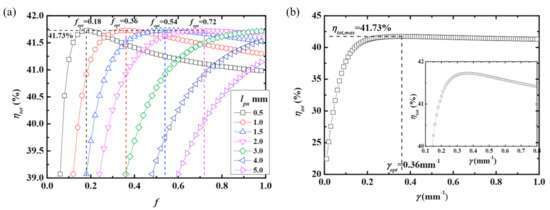
Figure 1.
Conversion efficiency variation with structural parameters [62]. (a) Ratio of thermoelectric elements’ total cross-section to ceramic plate; (b) ratio of thermoelectric elements’ total cross-section to height [62] (reproduced with permission from Ge et al., Energy, published by Elsevier, 2022).
Yilbas and Sahin [63] theoretically analyzed the relationship between the conversion efficiency of thermoelectric elements and external load parameters (Y), as well as the ratio of cross-sectional area to height (X), as illustrated in Figure 2. As X and Y increase, the maximum efficiency peaks at specific values of X and Y. The study found that Y varies with X, and the efficiency is optimal when X is less than 1, regardless of the external load. Unlike Ref. [63], Fan et al. [64] directly adopted leg length and cross-section area as research objectives instead of correlation factors. Figure 3a,b reveal distinct efficiency trends: constant efficiency under fixed temperature (Case 1); efficiency rises with leg length under fixed heat transfer coefficient (Cases 2–3); higher heat transfer coefficient boosts efficiency (Case 3); and efficiency slightly increases with the increase in cross-sectional area (Case 4) but declines under fixed heat transfer coefficient (Cases 5–6).
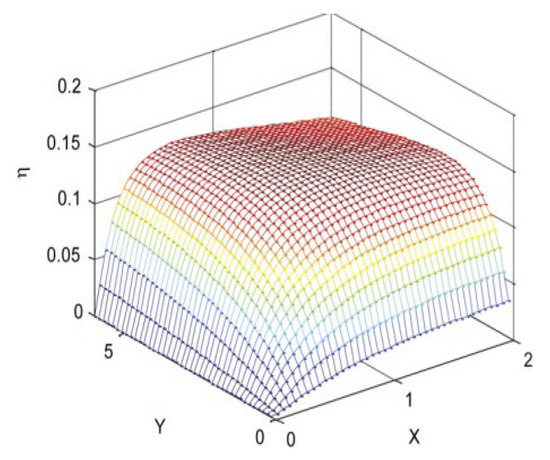
Figure 2.
Effects of ratio of cross-sectional area to height and external load on conversion efficiency [63] (reproduced with permission from Yilbas et al., Energy, published by Elsevier, 2010).
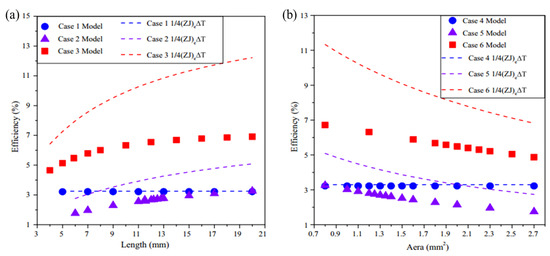
Figure 3.
Effects of leg lengths and cross-sectional areas on efficiency [64]: (a) length of thermoelectric elements; (b) cross-section area of thermoelectric elements [64] (reproduced with permission from Fan et al., Energy Conversion and Management, published by Elsevier, 2016).
Mechanical performance and thermal stress distribution are also key focuses for researchers. In Ref. [65], the impact of periodic heat sources on the output and mechanical performance of TEM was evaluated. Microstructure analysis revealed that periodic heat sources can induce mechanical defects in thermoelectric legs, with the cold-end joints of thermoelectric legs being more prone to damage. Therefore, the effects of reduced mechanical performance or uneven thermal stress distribution should be considered in the design.
As mentioned above, the structural optimization of TEM should take into account the influence of cross-sectional area, height, and mechanical performance. Currently, TEM structure can be categorized into segmented, non-segmented, and multi-stage, with the details as follows.
2.2.1. Segmented TEM
Each semiconductor in segmented TEM contains more than two types of materials with overall dimensions in a fixed range. Some structural designs of segmented TEM are illustrated in Figure 4. Figure 4a–d are two segmented TEMs, Kim et al. [66] designed segmented cuboid TEM with high power density, which is easy to integrate and suitable for most heat recovery applications. To adapt to circle heat sources, Shittu et al. [67] developed annular segmented TEM, maximum von Mises stress exhibits a progressive decline with increasing arc curvature. The surface between the hot-end and soldered joints more likely produces mechanical defects at constant hot temperature; He et al. [68] further optimized annular segmented TEM to biconical structure, the TEG composed of biconical TEM outputs higher power and exergy efficiency; Erturun et al. [69] investigated cylinder segmented TEM, they found that cylinder has lower maximum equivalent stress than rectangular segmented TEM. Zhang et al. [70] designed three segmented cuboid TEM (Figure 4e) to match a large temperature gradient. They classified thermoelectric materials into high/medium/low-temperature ranges and derived optimal parameters for each. Figure 4f depicts four segmented TEM [71] optimized via geometry adjustments (height and cross-section) to align material–current compatibility, achieving peak efficiency.
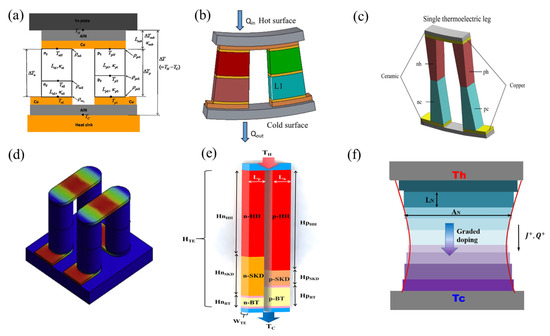
Figure 4.
Segmented TEM designed by (a) Kim et al. [66] (reproduced with permission from Kim et al., Materials Science and Engineering: B, published by Elsevier, 2014); (b) Shittu et al. [67] (reproduced with permission from Shittu et al., Energy Conversion and Management, published by Elsevier, 2019); (c) He et al. [68] (reproduced with permission from He et al., Energy, published by Elsevier, 2024); (d) Erturun et al. [69] (reproduced with permission from Erturun et al., Applied Thermal Engineering, published by Elsevier, 2014); (e) Zhang et al. [70] (reproduced with permission from Zhang et al., Applied Thermal Engineering, published by Elsevier, 2024); (f) Wu et al. [71] (reproduced with permission from Wu et al., Energy, published by Elsevier, 2018).
2.2.2. Non-Segmented TEM
In non-segmented TEM, each semiconductor material is uniformly distributed. By optimizing the overall parameters of the TEM, the ZT value can be improved or thermal stress can be reduced, thereby expanding the range of applications. The typical shapes are shown in Figure 5. Figure 5a,b are annular TEM for circle heat sources, and Figure 5c is groove-type TEM. The function of brackets is to increase heat absorption, but the lower height of brackets may exceed the limit value. Oki et al. [72] have designed a TEM with a square truncated pyramid configuration. The output power and efficiency are proportional to the angle of inclination at constant temperature, while the opposite is the case at constant heat flow. Figure 5d is cylinder type, which is useful for micro-thermoelectric devices, and Figure 5e is L type to accommodate different thermoelectric parameters of P- and N-type semiconductors. According to [73], the height increases with the increase in the thermoelectric parameter gap between P- and N-type semiconductors. Figure 5f,g has a non-constant cross-section area, the curve on the side is a nonlinear function, and the shapes can be adjusted based on the temperature gradient. Wang et al. [74] designed a TEM with X-shaped legs. It has a linear function curve on the side with a minimum cross-sectional area in the middle plane. The minimum cross-sectional area determines the maximum von Mises stress and current density. Figure 5h is designed by Erturun et al. [69]. They compared the maximum equivalent stress of octagonal prism and rectangular prism. Octagonal prism has lower maximum equivalent stress than rectangular prism, while a higher maximum equivalent stress than cylinder TEM. Figure 5i,j are designed in Ref. [75], which are I-leg and Y-leg, respectively. It is found that both shapes reduce von Mises stresses compared to conventional structures. Figure 5c–j own planar hot and cold sides, which are easy to integrate for multi-stage TEM, while Figure 5a,b cannot integrate because different stage matches different radians.
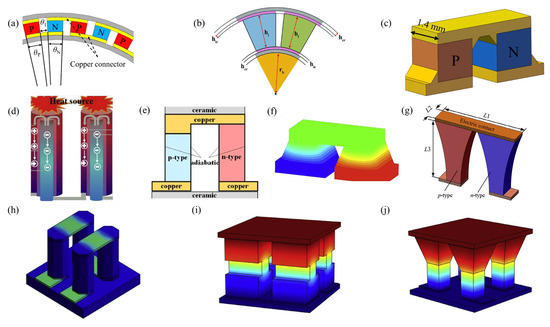
Figure 5.
Different shapes designed by (a) Luo et al. [76] (reproduced with permission from Luo et al., Energy Conversion and Management, published by Elsevier, 2024); (b) Zhou et al. [77] (reproduced with permission from Zhou et al., Case Studies in Thermal Engineering, published by Elsevier, 2024); (c) Luo et al. [78] (reproduced with permission from Luo et al., Applied Thermal Engineering, published by Elsevier, 2025); (d) Liu et al. [79] (reproduced with permission from Liu et al., Journal of Power Sources, published by Elsevier, 2018); (e) Luo et al. [73] (reproduced with permission from Luo et al., Energy, published by Elsevier, 2024); (f) Niu et al. [80] (reproduced with permission from Niu et al., International Journal of Heat and Mass Transfer, published by Elsevier, 2015); (g) Shi et al. [81] (reproduced with permission from Shi et al., Energy Conversion and Management, published by Elsevier, 2015); (h) Erturun et al. [69] (reproduced with permission from Erturun et al., Applied Thermal Engineering, published by Elsevier, 2014); (i,j) Ibeagwu [75] (reproduced with permission from Ibeagwu, Energy, published by Elsevier, 2019).
The aforementioned TEM are all one-stage TEM. If there are more than two ceramic plates between the hot and cold sides, the structure is termed a multi-stage TEM.
2.2.3. Multi-Stage TEM
Figure 6 illustrates two-stage TEM. Figure 6a–c use the same semiconductors in different stages for their own applications, and Figure 6d matches different semiconductors for different stages. Most researchers put TEM in series to obtain higher output power, while conversion efficiency may decrease as the number of TEM increases [82]. Therefore, it is important to balance output performance with cost. Moreover, the connection of TEM, including series, parallel, and hybrid (series-parallel) configurations, should be optimized due to its influence on output power and voltage uniformity.
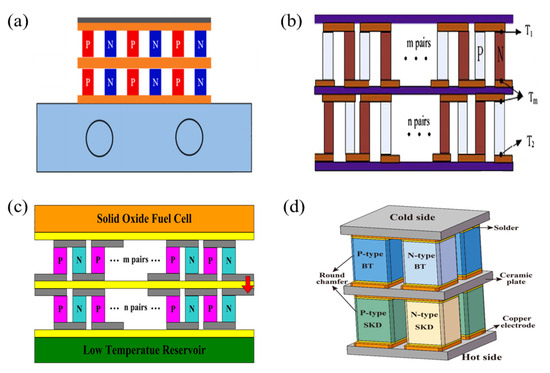
Figure 6.
Two-stage TEM applied in (a) solar TEG [83] (reproduced with permission from Long et al., Applied Thermal Engineering, published by Elsevier, 2024); (b) automotive TEG [84] (reproduced with permission from Liang et al., Applied Energy, published by Elsevier, 2014); (c) fuel cells TEG [85] (reproduced with permission from Zhang et al., Energy, published by Elsevier, 2017); (d) radioisotope TEG [82] (reproduced with permission from Bian et al., Applied Thermal Engineering, published by Elsevier, 2025).
A comprehensive analysis of automotive exhaust heat recovery systems indicates that the demanding operational conditions—characterized by sustained vibration and broad temperature variations—require balanced structural properties to match this harsh environment. Segmented TEMs enhance dynamic exhaust energy capture efficiency through multi-material integration but exhibit microcracking susceptibility at heterogeneous material interfaces under vibrational stress. Non-segmented TEMs achieve optimal vibration resistance and cost-efficiency via homogeneous materials yet demonstrate limitations in single-peak temperature optimization and dynamic response. Multi-stage TEMs mitigate thermal degradation through temperature staging, improving durability while utilizing flexible interconnects for vibration damping.
Non-conventional geometries (e.g., annular/trapezoidal) optimize thermal stress distribution and conform to complex heat sources, offering superior mechanical strength compared to rectangular configurations despite higher manufacturing costs. Advances in laser processing and additive manufacturing [86,87,88] show potential for reducing production costs of complex geometries, accelerating industrial adoption. Nevertheless, rectangular TEMs remain the preferred solution in thermoelectric semiconductor design owing to their manufacturing simplicity, uniform thermal/electrical field distribution, high mechanical stability, and favorable cost–benefit profile [89].
3. Structure Design and Optimization of HEX
As the critical component responsible for thermal energy transfer to TEMs, the HEX requires a compact structural design for seamless integration into the exhaust system while maximizing heat transfer efficiency. Current research prioritizes dual-path optimization of external geometries and internal architectures to address these objectives.
3.1. External Structure
The HEXs predominantly adopt three configurations: plate, polygonal, and annular geometries. While various cross-sectional shapes (e.g., rectangular, triangular, trapezoidal, and octagonal) have been investigated [14], plate designs demonstrate optimal thermal performance under equivalent perimeter conditions; therefore, plate design is widely adopted.
3.1.1. Plate HEX
The plate HEX features a compact structure, strong flexibility, and ease of modular design, making it convenient for cleaning and maintenance.
Figure 7 illustrates some typical plate HEXs. As we can see, TEMs are installed on the upper and lower surfaces, while no TEMs are installed in the height direction. However, the height can effectively regulate the backpressure. Therefore, structural optimization focuses on the length, width, and height of the HEX. Chen et al. [90] proposed an optimization method. The width and length of HEX are determined by the number of TEM, while height is restricted to a certain range. Luo et al. [91] comprehensively optimized the configuration of HEX to achieve higher output power. They proposed some criteria to guide selecting parameters of HEX: higher net power for performance, compact structure for actual space, and less TEM for cost.
Although traditional plate HEX can accommodate TEM in terms of length and width orientation, it suffers from drawbacks such as temperature non-uniformity and low power output. To improve the uniformity of temperature distribution and increase output power, some researchers have modified plate HEX. Chen et al. [92] proposed a segmented convergent plate HEX, which effectively addresses the temperature non-uniformity of TEMs in the downstream exhaust, thereby improving voltage consistency and enhancing output power. Luo et al. [93] and Wang et al. [94] extend HEX by adding extra plate structure on the sides, employing advanced heat transfer techniques to effectively increase the number of TEMs and boost output performance.
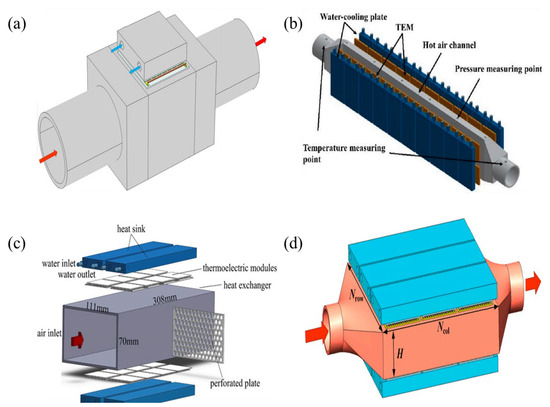

Figure 7.
Examples of plate HEX for automotive TEG: (a) Luo et al. [95] (reproduced with permission from Luo et al., Renewable Energy, published by Elsevier, 2021); (b) Ge et al. [96] (reproduced with permission from Ge et al., Applied Energy, published by Elsevier, 2022); (c) Zhao et al. [97] (reproduced with permission from Zhao et al., Energy, published by Elsevier, 2023); (d) Chen et al. [90] (reproduced with permission from Chen et al., Applied Energy, published by Elsevier, 2024).
The prototypes of the plate HEX are shown in Figure 8. Bench testing (Figure 8a–d and Figure 8g–i) and installation on actual vehicles (Figure 8e,f) are two major ways to validate the performance of TEG. Ni et al. [16] established an engine bench to compare the output power under different coolant flow rates and engine loads. They found that the performance of the TEG is significantly affected by engine load and coolant flow rate. Lan et al. [98] discovered that the performance of plate HEX varies across different vehicle types and driving cycles, necessitating optimized design based on specific application scenarios. Risseh et al. [99] designed a plate HEX installed on a Scania heavy-duty truck, capable of generating a maximum output power of 1 kW. To further optimize the TEG, Lan et al. [100] designed a plate HEX prototype with 20 TEMs based on Figure 8b, achieving a maximum output power of 224 W. To study the transient output performance of the plate TEG, Massaguer et al. [101] conducted transient tests under driving cycles, finding that the TEG struggles to reach a thermal steady state due to variations in exhaust temperature and mass flow, resulting in lower total energy generation than predicted by steady-state analysis. Therefore, optimizing heat transfer performance, reducing thermal inertia, and reasonably controlling pressure drop are key to improving the performance of plate HEX in TEG [102].
From the output results of the aforementioned prototypes, it is evident that single-layer TEG produces relatively low output power [103], while multi-layer TEG can generate several times the output power of single-layer designs, with the largest TEG output power reaching the kW level. This is attributed to the easy integration feature of plate HEX, allowing for the integration of more TEMs, a characteristic not shared by HEX of other shapes.
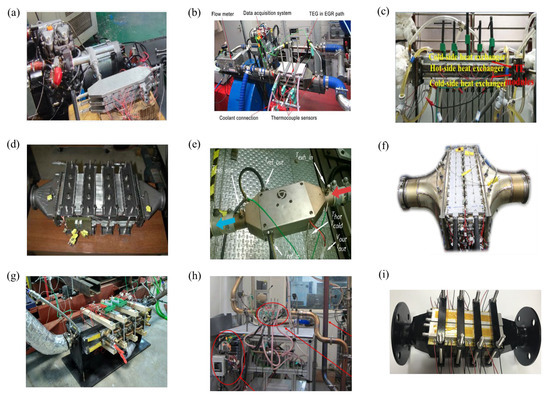

Figure 8.
Prototypes of TEG with plate HEX designed by (a) Ni et al. [16] (reproduced with permission from Ni et al., Energy, published by Elsevier, 2024); (b) Lan et al. [98] (reproduced with permission from Lan et al., Applied Energy, published by Elsevier, 2022); (c) Lu et al. [104] (reproduced with permission from Lu et al., Energy Conversion and Management, published by Elsevier, 2017); (d) Wang et al. [105] (reproduced with permission from Wang et al., Applied Thermal Engineering, published by Elsevier, 2016); (e) Massaguer et al. [101] (reproduced with permission from Massaguer et al., Applied Energy, published by Elsevier, 2017); (f) Zhang et al. [106] (reproduced with permission from Zhang et al., Energy Conversion and Management, published by Elsevier, 2015); (g) Fernández-Yañez et al. [107] (reproduced with permission from Fernández-Yañez et al., Applied Energy, published by Elsevier, 2018); (h) Lan et al. [100] (reproduced with permission from Lan et al., Energy Conversion and Management, published by Elsevier, 2022); (i) Luo et al. [108] (reproduced with permission from Luo et al., Applied Energy, published by Elsevier, 2020).
3.1.2. Polygonal HEX
The polygonal structure offers a larger heat exchange area than single-layer plate HEX, significantly increasing the output voltage and power. It boasts high design flexibility, allowing for adjustments in the number of sides, angles, and dimensions to meet specific application requirements, thereby optimizing heat transfer and flow field distribution [109]. The cross-sections of typical polygonal HEX are hexagonal and octagonal [110].
Hexagonal HEX models are shown in Figure 9a–e, and Figure 9f,g are octagonal HEX models. Luo et al. [6] designed two different hexagonal HEX models. In Figure 9a, they built a prototype of stacked TEG, whose cross-sectional shape is a hexagon with no fins. Heat pipes are used on the hot side and cold side to increase heat transfer. The TEG can output 848.37W power, calculated by simulations and experiments. In Figure 9c, there are diverging fins instead of heat pipes, the cross-sectional shape is a circle, and the maximum output power can reach 143.94 W [13]. Although Weng et al. [111] investigated a hexagonal HEX model with the same shape of diverging fins as in Ref. [13], the length radio of TEG and HEX is the research object, the results indicated that the length radio of TEG and HEX is about 40–45% considering the economical cost. Kim et al. [112] studied a hexagonal HEX model with rectangular fins that are perpendicular to edges. The results showed that the hot-side temperature is significantly influenced by engine load and speed, which have a positive effect on temperature. Yang et al. [113] compared the integration of TEG and three-way catalyst (TWC) with single TEG. They found that the net power of integration of TEG and TWC is 37% higher than single TEG, and an excess number of TEM decreases the temperature of TWC. It is important to balance the gain of TEG and the efficiency of TWC. Bai et al. [114] simulated a hollow octagonal HEX model with or without metal foam, and it was found that octagonal HEX with metal foam output power can reach 323.424 W. In addition to the improved heat transfer of the metal foam, the octagonal structure is also able to carry more TEMs.
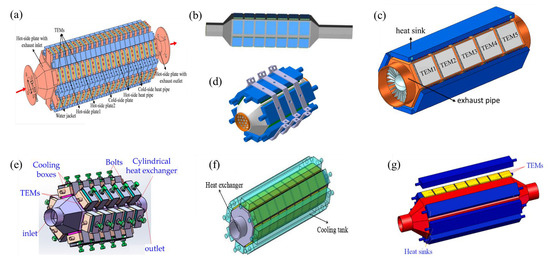
Figure 9.
Polygonal HEX models in (a) Luo et al. [6] (reproduced with permission from Luo et al., Device, published by Elsevier, 2024); (b) Yang et al. [113] (reproduced with permission from Yang et al., Applied Thermal Engineering, published by Elsevier, 2018); (c) Luo et al. [13] (reproduced with permission from Luo et al., Energy, published by Elsevier, 2024); (d) Kim et al. [112] (reproduced with permission from Kim et al., Energy Conversion and Management, published by Elsevier, 2018); (e) Quan et al. [115] (reproduced with permission from Quan et al., Energies, published by MDPI, 2020); (f) Bai et al. [114] (reproduced with permission from Bai et al., Applied Thermal Engineering, published by Elsevier, 2017); (g) Quan et al. [8] (reproduced with permission from Quan et al., Applied Thermal Engineering, published by Elsevier, 2025).
3.1.3. Annular HEX
Annular HEX can be flexibly arranged within limited space, enhancing the compactness of the system. Particularly in automotive exhaust waste heat recovery [116]. Figure 10 displays the schematic diagram of annular HEX [117], which is integrated by diverging fins and hollow cavities. The hollow cavity reduces backpressure loss but also wastes heat. Chen et al. designed a baffle in the annular channel to improve temperature uniformity.
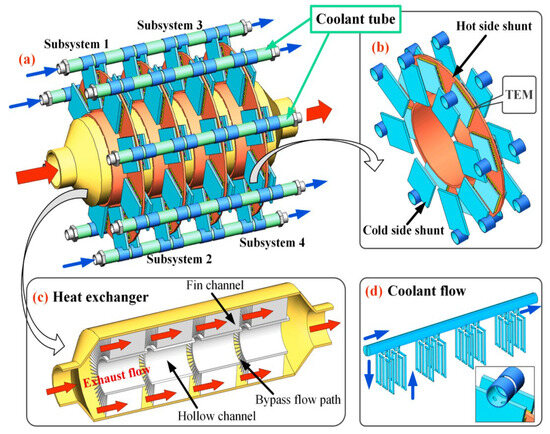
Figure 10.
An annular HEX model in Ref. [117]: (a) overall structure; (b) single-TEM system; (c) cross-section of HEX; (d) diagram of HSK [117] (reproduced with permission from Chen et al., Energy Conversion and Management, published by Elsevier, 2025).
The research objectives of annular HEX primarily focus on TEM structural design (Figure 11a,h–j), structural configurations for enhancing internal heat transfer (Figure 11b–e,i) and mitigating temperature fluctuations (Figure 11c,f,g), as well as optimizing practical output performance (Figure 11k). Luo et al. [76] proposed an annular TEG with a TEM cross-sectional area that increases along the direction of heat flow, optimizing the length difference between element columns. Wu et al. [71] and Li et al. [118] both highlighted that technologies such as laser sintering and 3D printing facilitate the manufacturing of complex structures, offering new avenues for TEG production. To enhance heat transfer, Luo et al. [119] integrated vapor chambers into the annular TEG, leveraging the excellent thermal conductivity and temperature uniformity of vapor chambers to improve heat absorption and output power. Li et al. [120] utilized a heat pipe to strengthen the heat transfer of annular HEX, noting that a heat pipe not only transfers heat but also minimizes temperature fluctuation at the hot end of TEM under transient conditions. Yang et al. [121] developed a three-dimensional numerical model to optimize the pin fin of annular TEG. Shen et al. [122] investigated the impact of multiple structural parameters on the performance of annular TEG. The results showed that thermoelectric leg height and central angle have a minor impact on maximum net power. Yang et al. [123] proposed a concentric annular HEX and studied the influence of HEX dimensions on performance, revealing that an optimized inner-to-outer diameter ratio of the HEX yields maximum output power.
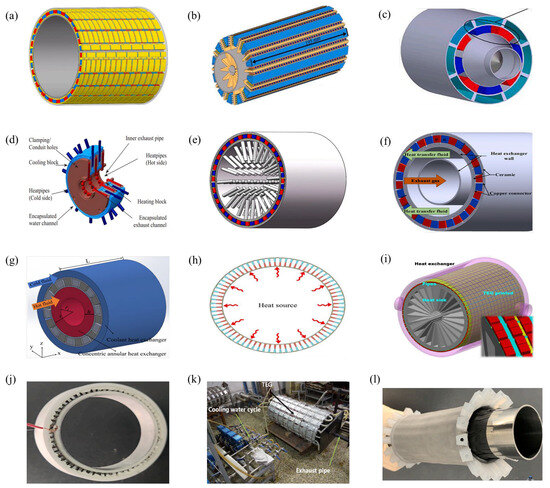
Figure 11.
Schematic diagrams and prototypes of annular HEX. (a) Luo et al. [76] (reproduced with permission from Luo et al., Energy Conversion and Management, published by Elsevier, 2024); (b) Luo et al. [119] (reproduced with permission from Luo et al., Energy, published by Elsevier, 2024); (c) Shen et al. [122] (reproduced with permission from Shen et al., Energy Conversion and Management, published by Elsevier, 2022); (d) Li et al. [120] (reproduced with permission from Li et al., Applied Energy, published by Elsevier, 2017); (e) Yang et al. [121] (reproduced with permission from Yang et al., Renewable Energy, published by Elsevier, 2024); (f) Yang et al. [124] (reproduced with permission from Yang et al., Energy, published by Elsevier, 2023); (g) Yang et al. [123] (reproduced with permission from Yang et al., Energy, published by Elsevier, 2022); (h) He et al. [68] (reproduced with permission from He et al., Energy, published by Elsevier, 2024); (i) Wu et al. [71] (reproduced with permission from Wu et al., Energy, published by Elsevier, 2018); (j) Li et al. [118] (reproduced with permission from Li et al., Applied Thermal Engineering, published by Elsevier, 2024); (k) Wan et al. [125] (reproduced with permission from Wan et al., Applied Thermal Engineering, published by Elsevier, 2019); (l) Liu et al. [7] (reproduced with permission from Liu et al., Energy Conversion and Management, published by Elsevier, 2024).
3.2. Inner Structure
Six different structures of HEX in Figure 12 are comprehensively investigated, including heat absorption, backpressure loss, output power, and physical field distributions [126]. The results showed that HEX with serial baffles yields maximum output power while also leading to maximum backpressure loss. On the contrary, the hollow HEX outputs minimum power and backpressure loss, and the tendency of heat absorption is consistent with output power. It is important to trade off extra power loss and output power. The inner structure of HEX should be optimized according to specific conditions.
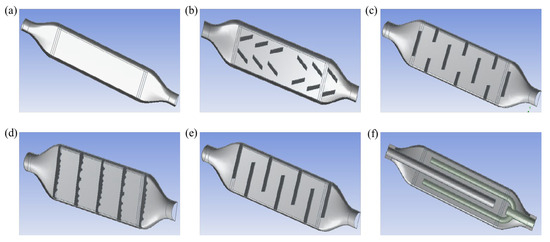
Figure 12.
Different inner structures of HEX. (a) Empty HEX; (b) slanted baffles; (c) short parallel baffles; (d) separate baffles with holes; (e) serial baffles; (f) pipe structure [126] (reproduced with permission from Bai et al., Case Studies in Thermal Engineering, published by Elsevier, 2014).
3.2.1. Fin
Fins function to augment the heat transfer surface area and are typically oriented parallel to the exhaust gas flow direction. The main fin types (rectangular, triangular, offset, pin, and diverging) prioritize rectangular fins for their structural simplicity, manufacturability, and cost-effectiveness. Figure 13 shows some rectangular fins applied in plate and annular HEXs. Increasing fin count boosts heat absorption but escalates backpressure losses, necessitating optimization of fin thickness and spacing to balance thermal gain and power loss. Studies on rectangular fins [127] revealed that reduced spacing enhances heat absorption, yet backpressure spikes critically below 2 mm, mandating power loss consideration during design.
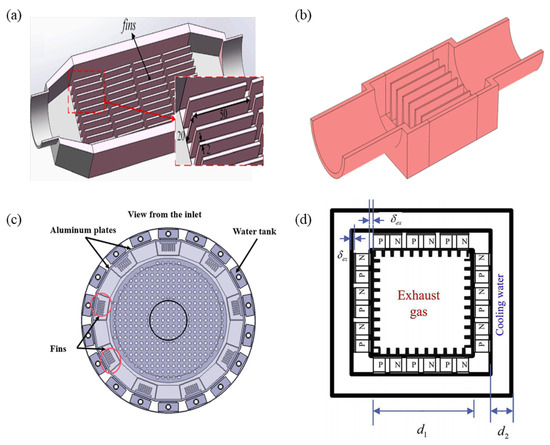
Figure 13.
Rectangular fin in (a) Chen et al. [128] (reproduced with permission from Chen et al., Applied Thermal Engineering, published by Elsevier, 2022); (b) Luo et al. [129] (reproduced with permission from Luo et al., Applied Energy, published by Elsevier, 2021); (c) Wan et al. [125] (reproduced with permission from Wan et al., Applied Thermal Engineering, published by Elsevier, 2019); (d) Meng et al. [130] (reproduced with permission from Wan et al., Energy, published by Elsevier, 2017).
Four internal topologies in Figure 14, including long rectangular fins, inclined rectangular fins, and serial plates, were tested by Fernández-Yañeza et al. [107]. The authors found that in actual application, a simple fin and baffle are necessary for low backpressure loss and higher net power. Studies on inclined and vertical fins revealed that non-uniform TEM temperature distribution reduces voltage uniformity. To solve the problem, Lu et al. [104] demonstrated that non-uniform fins enhance TEG output power under turbulent flow conditions compared to uniform and hollow HEX, particularly when a significant temperature gradient exists, and external resistance is within 2.5 times internal resistance, with denser fins positioned upstream proving optimal.
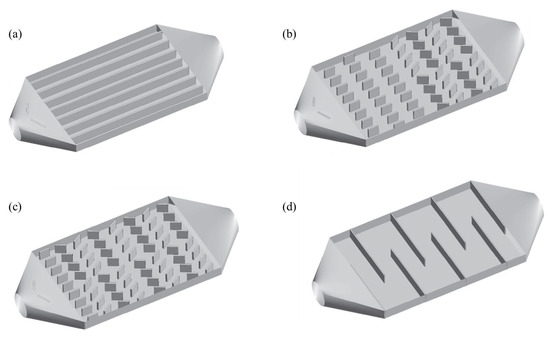
Figure 14.
Four internal topologies. (a) Long rectangular fins; (b) half-inclined short fins; (c) mostly inclined short fins; (d) serial plates [107] (reproduced with permission from Fernández-Yañez et al., Applied Energy, published by Elsevier, 2018).
Offset fins enhance heat transfer but induce higher flow resistance than rectangular fins. Vale et al. [131] demonstrated rectangular fins’ greater sensitivity to spacing variations, with optimal configurations maximizing net power. As shown in Figure 15, Marvão et al. [132] identified long rectangular and offset fins as superior for power output depending on exhaust and cooling conditions, outperforming uniform triangular fins. Su et al. [133] analyzed segmented triangular fins, showing length dominance over width in thermal regulation: increasing third-segment length raises average temperature, while third-segment width most impacted temperature uniformity, which peaked at specific segment lengths before declining.
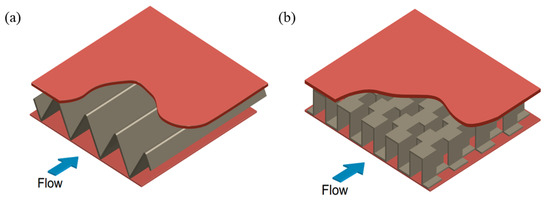
Figure 15.
Fin structure of HEX [132]. (a) Uniform triangular fins; (b) offset strip fins [132] (reproduced with permission from Marvão et al., Energy Conversion and Management, published by Elsevier, 2019).
In addition to conventional fins, researchers have explored novel fin configurations. Diverging fin is typically employed in annular HEX (Figure 9c, Figure 10 and Figure 11i). Pin fin exhibits advantages in compact size and high heat transfer efficiency, finding applications in wearable devices and automotive exhaust heat recovery systems (Figure 11e). Split fin [134] demonstrates significant enhancement in downstream exhaust gas temperature compared to traditional rectangular fins. Twisted tape inserts [135] effectively augment vortex generation, thereby improving heat transfer performance through intensified turbulent mixing.
3.2.2. Dimple
Unlike rectangular and triangular fins, a dimple can be either embedded into the inner wall of HEX [136] or integrated with other fins [137], as shown in Figure 16.
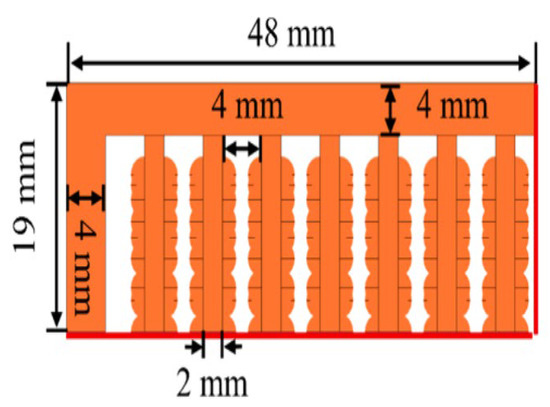
Figure 16.
Dimples installed on surfaces of rectangular fins [137] (reproduced with permission from Luo et al., Applied Thermal Engineering, published by Elsevier, 2024).
Turnow et al. [138] investigated the flow pattern of staggered dimples. The results demonstrated that optimal thermodynamic performance occurs at a depth-to-diameter ratio of 0.26, with staggered dimples achieving 201% higher heat transfer rates than smooth channels. Rao et al. [136] investigated shallow dimpled channels with three depth/diameter ratios, revealing turbulent flow variations across dimple depths. Shallow dimples improved heat transfer uniformity at elevated Reynolds numbers but intensified heat transfer–backpressure trade-offs. Wang et al. [139] proposed a symmetric staggered dimple configuration. Numerical simulation showed these dimpled surfaces significantly improve heat transfer coefficient, delivering 15% greater power generation at Re = 25,000 compared to plate HEX, with comparable pressure drop. To develop advanced fin designs, Wang et al. [140] compared irregular short rectangular fins with dimples through road tests. The dimpled HEX demonstrated superior performance with 20% lower pressure distribution and 173.6% higher net power output. Researchers found that dimple universally improves efficiency and output power, with C-type configuration showing the most significant enhancement [141].
While previous studies focused on surface-mounted dimples, Ref. [137] specifically examined dimples versus rectangular fins. Numerical simulation revealed that an optimal dimple arrangement achieves over 20% improvement in conversion efficiency compared to plate HEX. These collective findings position dimple as a promising approach for substantial thermal efficiency gain.
3.2.3. Heat Pipe
Heat pipes operate on liquid–vapor phase-change principles, transferring heat through fluid evaporation and condensation. Their structures primarily include cylindrical, flat-plate, and annular configurations, with shape selection depending on application-specific factors [142].
Commercial cylindrical heat pipes typically comprise a sealed shell, wick structure, working fluid, evaporator, condenser, and adiabatic section [143]. Heat pipes maintain TEM temperature stability, prevent overheating damage, and enhance heat transfer efficiency [144].
Figure 17 demonstrates the application adaptability of heat pipes in TEGs across diverse heat HEX layouts compatible with commercial TEMs. Specifically, Figure 17a,b analyze annularly distributed heat pipes in annular TEG systems. Horizontal heat pipe impacts are investigated for flat-plate TEGs in Figure 17c–f, with Figure 17f further evaluating their effects on polygonal TEG configurations. Chi et al. [145] examined vertical heat pipe configurations on plate TEG performance. Collectively, these studies underscore the layout flexibility of heat pipes with commercial TEMs. Orr et al. [146] constructed a test rig with heat pipes transferring heat from both hot and cold sides. Maximum power output occurs when the HEX is positioned below the HSK, minimizing backpressure loss and optimizing heat transfer efficiency. Chi et al. [145] identified that optimal power output occurs at 20–30° inclination angles with specific working fluid charges. Pacheco et al. [147] developed a prototype with horizontally arranged heat pipes, demonstrating that horizontal configurations mitigate overheating risks through vaporization-driven heat redistribution while improving temperature uniformity. Moreover, Li et al. [148] compared horizontal and vertical orientations in a two-stage TEG, revealing that vertical alignment maximizes thermal conductivity due to gravitational assistance.
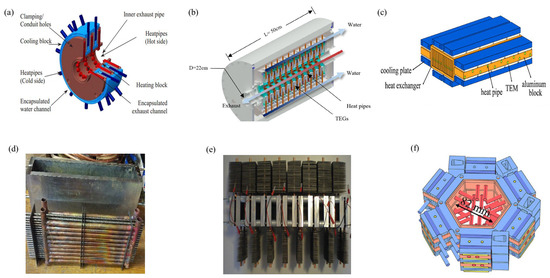
Figure 17.
Heat pipes applied in (a) [120] (reproduced with permission from Li et al., Applied Energy, published by Elsevier, 2017); (b) [105] (reproduced with permission from Wang et al., Applied Thermal Engineering, published by Elsevier, 2016); (c) [93] (reproduced with permission from Luo et al., Energy Conversion and Management, published by Elsevier, 2024); (d) [147] (reproduced with permission from Pacheco et al., Energy, published by Elsevier, 2020); (e) [149] (reproduced with permission from Orr et al., Applied Thermal Engineering, published by Elsevier, 2017); (f) [6] (reproduced with permission from Luo et al., Device, published by Elsevier, 2024).
3.2.4. Intermediate Fluid
The integration of intermediate fluids in HEX primarily ensures uniform heat transfer, accommodates complex geometric configurations, and mitigates thermal shock. Based on phase-change utilization, these fluids are categorized into non-phase-change fluids (e.g., oil) and phase-change fluids (e.g., water or liquid metal).
TEG employing non-phase-change fluids typically adopts flow channel configurations, as exemplified in Figure 11c,f. In contrast, phase-change fluid systems retain essential components: evaporator, working fluid, and condenser, analogous to heat pipes but with distinct operational mechanisms, as illustrated in Figure 18. Figure 18a shows a plate-type design with direct exhaust contact at the evaporator, functioning as a fin. Figure 18b features a rectangular HEX with wavy fins replacing corrugated tubes, where exhaust transfers heat through perforations to an intermediate fluid that stabilizes hot-side temperature. Zhao et al. [150] positioned intermediate fluid between TEM and the exhaust pipe, transferring latent heat to protruding ribs where TEM is mounted. Reduced rib surface area increases TEM heat absorption and operating temperatures compared to conventional HEX. Figure 18c,d demonstrate intermediate fluid system enables TEM relocation strategies for spatial flexibility. According to [151], while intermediate fluids enhance thermal transport and mitigate thermal shock, TEM temperatures remain predominantly governed by heat source conditions, underscoring the need for scenario-specific configuration designs.
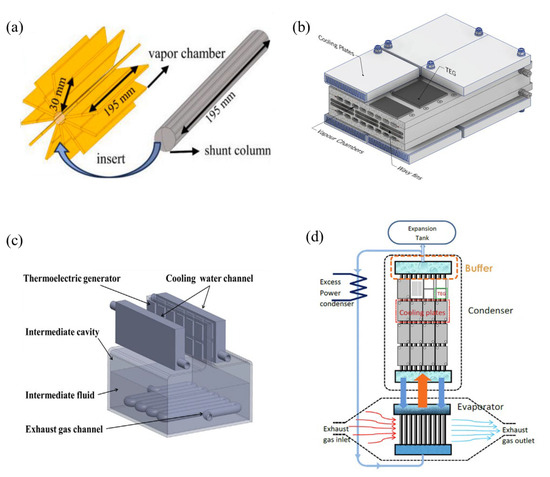

Figure 18.
Intermediate fluid system configurations. (a) Plate type [119] (reproduced with permission from Luo et al., Energy, published by Elsevier, 2024); (b) horizontal flat type [152] (reproduced with permission from Sousa et al., Energies, published by MDPI, 2022); (c) cubic type [150] (reproduced with permission from Zhao et al., Applied Energy, published by Elsevier, 2019); (d) vertical type [153] (reproduced with permission from Brito et al., Energy Conversion and Management, published by Elsevier, 2020).
3.2.5. Baffle
Baffles are conventionally oriented perpendicular or at an inclination to the exhaust flow direction, primarily aiming to optimize flow field uniformity and intensify turbulent mixing rather than increasing heat transfer surface area. They can function independently (Figure 7c, Figure 12c–e, Figure 14d, and Figure 19a–d) or synergistically with other designs to amplify flow disturbance (Figure 19e) or streamline channels (Figure 19f–h). Numerical results in Figure 20 correspond to Figure 19, with identical reference sources.
Figure 20 demonstrates that baffle arrangements differentially influence exhaust flow. Parallel-aligned baffles in Figure 19h minimally perturb flow. Identical baffles with bottom grooves in Figure 19f achieve higher heat transfer coefficients than in Figure 19h. Wall-mounted baffles in Figure 19b only alter velocity profiles near boundaries, leaving central flow largely unaffected. Angled baffles in Figure 19d, uniformly distributed in four pairs, significantly modify velocity streamlines. Wang et al. [154] optimized temperature uniformity by positioning short parallel baffles at the inlet to reduce backpressure and arranging irregular baffles in mid-rear sections.
Vertically oriented baffles are illustrated in Figure 19a,c,e. Figure 20e shows locally elevated downstream temperatures but with limited coverage. Parallel short baffles in Figure 19c maintain uniform velocity contours and high exit flow rates. The convergent HEX in Figure 19a, featuring uniformly spaced vertical baffles, maximizes flow velocity uniformity and thermal performance (Figure 20a). While baffles effectively redirect flow and modulate velocity, their limited heat area compared to extended fins reduces thermal transfer. Balancing flow acceleration and heat exchange area is critical, necessitating hybrid configurations combining multiple strategies when temperature gains are insufficient.
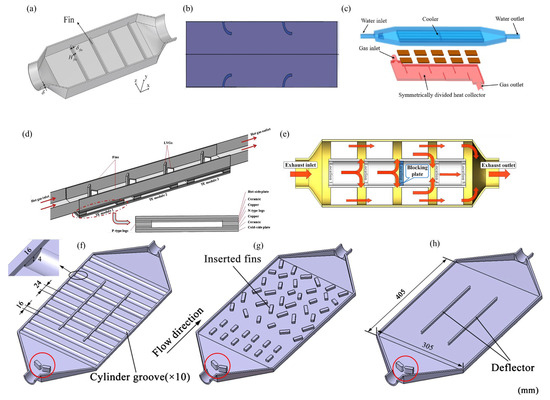
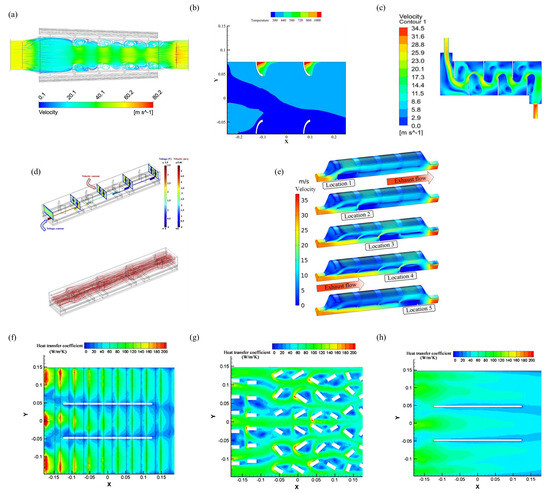

Figure 19.
Baffles types. (a) Long serial baffles [155] (reproduced with permission from Luo et al., Applied Thermal Engineering, published by Elsevier, 2019); (b) angled baffles [156] (reproduced with permission from Kubenova et al., International Journal of Low-carbon Technologies, published by Oxford University Press, 2025); (c) short serial baffles [16] (reproduced with permission from Ni et al., Energy, published by Elsevier, 2024); (d) “V”-type baffles [157] (reproduced with permission from Ma et al., Applied Energy, published by Elsevier, 2017); (e) single baffle [117] (reproduced with permission from Chen et al., Energy Conversion and Management, published by Elsevier, 2025); (f–h) baffles combined with different inner structures [154] (reproduced with permission from Wang et al., Energy Conversion and Management, published by Elsevier, 2016).

Figure 20.
Corresponding numerical results of Figure 19: (a) Exhaust streamlines [155] (reproduced with permission from Luo et al., Applied Thermal Engineering, published by Elsevier, 2019); (b) velocity contours [156] (reproduced with permission from Kubenova et al., International Journal of Low-carbon Technologies, published by Oxford University Press, 2025); (c) heat collector flow [16] (reproduced with permission from Ni et al., Energy, published by Elsevier, 2024); (d) velocity, voltage, and streamlines distributions [157] (reproduced with permission from Ma et al., Applied Energy, published by Elsevier, 2017); (e) velocity distributions [117] (reproduced with permission from Chen et al., Energy Conversion and Management, published by Elsevier, 2025); (f–h) convection heat transfer coefficient [154] (reproduced with permission from Wang et al., Energy Conversion and Management, published by Elsevier, 2016).
3.2.6. Metal Foam
Metal foam, a porous material composed of a metallic matrix with interconnected voids, is structurally analogous to polymer foams but inherits metallic mechanical strength, thermal conductivity, and high-temperature resistance. Its porous architecture significantly amplifies HEX surface area, enhances thermal efficiency by disrupting laminar flow to induce turbulence, attenuates acoustic waves for noise reduction, and offers low-density advantages for lightweight integration, making it a promising material for automotive TEG.
In automotive HEX applications, metal foam is predominantly used independently, as illustrated in Figure 21. Studies focus on porosity and pores per inch (PPI) impacts on temperature uniformity, parasitic power losses, and output performance. Notably, all configurations except Figure 21a,c employ uniform PPI foams. Jin et al. [158] implemented a five-layer graded PPI foam structure, showing that metal foam integration substantially increased TEG output power compared to smooth-walled HEXs, with graded porosity foams outperforming uniform counterparts in thermal efficiency. Similar to Figure 21a, Yang et al. [159] increased PPI along the exhaust flow direction to progressively improve voltage uniformity.
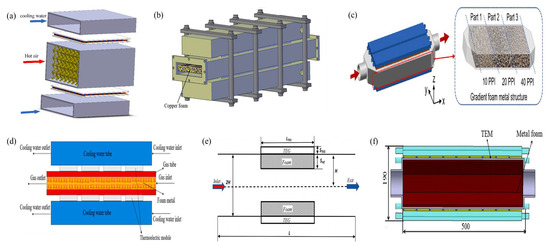
Figure 21.
Schematic diagram of TEGs using metal foams: (a) [158] (reproduced with permission from Jin et al., Thermal Science and Engineering Progress, published by Elsevier, 2024); (b) [160] (reproduced with permission from Fu et al., Processes, published by MDPI, 2023); (c) [159] (reproduced with permission from Yang et al., Renewable Energy, published by Elsevier, 2024); (d) [161] (reproduced with permission from Li et al., Thermal Science and Engineering Progress, published by Elsevier, 2022); (e) [162] (reproduced with permission from Buonomo et al., Thermal Science and Engineering Progress, published by Elsevier, 2023); (f) [114] (reproduced with permission from Bai et al., Applied Thermal Engineering, published by Elsevier, 2017).
3.2.7. PCM
PCM absorbs or releases substantial heat through solid–liquid phase transitions, characterized by high latent heat, isothermal behavior, stable temperatures, and low cost [163,164]. When integrated at the hot side of TEM, PCM exhibits delayed heat transfer to the TEM due to their phase transition process. Similarly, during sudden heat source disconnection or temperature reduction, PCM can sustain the TEM heat supply temporarily. Although PCMs are extensively applied in photovoltaic systems [163,165], their adoption in automotive TEGs remains limited. Klein Altstedde et al. [166] developed a TEG prototype with PCM mounted on the HEX surface contacting the TEM. Their experimental results demonstrate that PCM implementation under periodic thermal loading reduced TEM hot-side temperature fluctuations to within 50 °C, significantly stabilizing thermal fluctuations.
However, PCMs’ low thermal conductivity limits phase transition rates. To accelerate PCM liquefaction, metal foams can function synergistically with PCM, leveraging both their high thermal conductivity and PCMs’ latent heat storage capabilities [167]. For a hybrid PCM–metal foam system, investigations include porosity, PPI, PCM container dimensions, and material selections. Results confirmed synergistic performance enhancement over individual implementations. Material and structural optimizations remain essential for specific operational conditions and configurations [168,169].
For automotive exhaust heat recovery under demanding operational conditions, synergistic optimization of external and internal HEX structures is essential. Plate-type configurations offer modular adaptability to diverse exhaust pipe diameters, delivering significant cost-efficiency in spacious chassis layouts while requiring enhanced vibration resistance. Polygonal designs increase heat transfer area through geometric edges and structural rigidity, achieving superior power density at the expense of complex manufacturing processes. Annular architectures enable compact annular integration with exhaust systems, providing exceptional space utilization and vibration compliance though requiring internal enhancement to compensate for thermal efficiency limitations.
Regarding internal structures, rectangular fins deliver optimal cost-effectiveness; pin fins substantially extend heat transfer surfaces but incur vibration-induced fracture risks at root junctions; dimples simultaneously enhance vibration damping and turbulent intensity through stress-distributing geometries; heat pipes effectively homogenize temperature gradients to prevent TEM failure; and metal foam absorbs broadband vibrations while PCM buffers thermal transients, though their limited thermal conductivity requires hybrid implementation with other heat transfer technologies. Future advancements require integrated multimechanistic heat transfer enhancement strategies tailored to demanding automotive environments.
The aforementioned advanced heat transfer strategies have significantly accelerated the commercialization of TEGs. To systematically evaluate these advancements, Table 2 summarizes key research progress in this field over the past five years.

Table 2.
HEX types and corresponding output performance.
4. Structure Design and Optimization of HSK
HSK maximizes thermoelectric temperature gradients by rapidly dissipating cold-side heat, preventing temperature rise from heat accumulation, thereby improving power generation efficiency and extending material lifespan. Key design parameters include heat dissipation area, fin geometry, and fluid velocity, with optimizations significantly enhancing system performance [172,173]. HSKs are classified as active, passive, or hybrid based on TEG requirements.
Active HSK employs forced convection via fans (air-cooled) or pumps (water-cooled), offering high efficiency at the cost of additional energy consumption and system complexity. Automotive TEG predominantly adopts pump-driven water cooling to meet high-temperature, high-power demands.
Passive HSK relies on natural convection/radiation, utilizing fin [172], heat pipe, metal foam, or PCM [174]. PCM buffers temperature spikes via latent heat storage but require periodic regeneration, limiting their use to intermittent cooling scenarios like photovoltaic systems [163]. Tzeng et al. [175] demonstrated that pin-fin passive cooling outperforms finless designs in automotive TEGs, though less effective than active systems.
Hybrid HSK combines methods such as water cooling with heat pipe [6], forced air with fins [168], forced air with heat pipe [144], heat pipe with fins [144], heat pipe with PCM [148], or PCM with metal foam [167]. These remain secondary to water cooling in automotive applications.
In conclusion, current automotive TEG optimization focuses on active HSK improvements through coolant selection, flow path layout, and channel geometry refinements.
4.1. Coolant Selection
Automotive TEG predominantly uses water as the coolant. To enhance HSK efficiency, Hilmin et al. [176] introduced nanofluid. Nanofluid is a novel coolant with superior thermal conductivity comprising nanoscale metal/metal oxide particles dispersed in distilled water. The authors evaluated TiO2-water nanofluid cooling using a copper radiator substrate under real engine conditions (600–1500 rpm), assessing peak current, surface temperature gradient, output power, and conversion efficiency. Compared to water cooling, nanofluid significantly increases peak current and output power while reducing the cold-side temperature by up to 12.36%, demonstrating its effectiveness in enhancing TEG performance.
4.2. Flow Path Layout
He et al. [177] investigated optimal TEM areas under coolant aligned with exhaust direction and counter-flow direction. Results revealed that counter-flow improves 0.08 m2 larger optimal TEM area than the aligned direction and also produces smaller peak power deviations. Counter-flow is recommended in space-permissive designs.
Figure 22 depicts an annular water-cooling jacket for TEG [178], where coolant channels fully encase the TEG with inlet and outlet orientations perpendicular to exhaust flow. Coolant velocity critically influences pressure drop, which increases 16 times as velocity rises from 1 m/s to 5 m/s. This surge in pump power consumption causes rapid net power decline, even yielding negative values. Su et al. [179] constructed a TEG test rig to evaluate coolant flow rate, direction, and layout impacts under specific conditions. The results indicated that these parameters influence output performance. While higher flow rates increase the output voltage, escalating pump loss leads to net power quickly peaking before declining. Counter-flow configuration enhances temperature uniformity, and parallel-connected dual cooling units outperform serial arrangements in net power output. Optimal flow path layouts vary with engine operating conditions and TEM topologies to maximize net power.
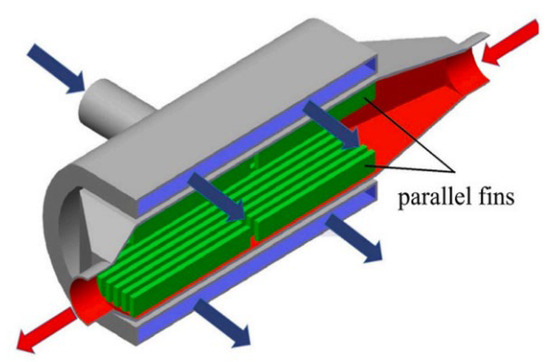
Figure 22.
Schematic diagram of cooling channel [178] (reproduced with permission from Zhou et al., Case Studies in Thermal Engineering, published by Elsevier, 2024).
4.3. Channel Geometry Refinements
Su et al. [180] studied the impact of multi-channel series configurations on TEG performance. The plate-shaped structure exhibits the lowest average pressure field but includes localized recirculating velocity fields detrimental to heat transfer. Experimental results showed alternating temperature maxima in stripe-shaped and diamond-shaped structures, with diamond-shaped structures consistently achieving the highest output power under identical engine speeds. All configurations demonstrate power enhancement with increasing engine speed. For a single-channel system, Zhu et al. [181] compared three internal topologies, including hollow channel, single channel with inserted fins, and cylindrical grooves. Uniform fins enhance heat transfer but increase backpressure. Cylindrical grooves on inner surfaces are designed to optimize heat transfer while minimizing backpressure loss. Simulations revealed that grooved surfaces improve heat transfer with lower pressure drop than finned or smooth surfaces, identifying an optimal groove depth ratio for peak power under specific engine conditions. To address automotive TEG cooling demands, a flexible liquid-metal-based HSK was developed in [7]. This HSK integrates gallium droplets and copper particles into a solid–liquid composite molded to match circular HEX; the process is illustrated in Figure 23. The composite’s high thermal conductivity effectively reduces TEG cold-end temperature. Simulation at 300 K coolant temperature and 0.4 m/s flow rate demonstrates that a 25 mm wide HSK with 16 perforations achieves optimal cooling performance and minimal cold-end temperature.
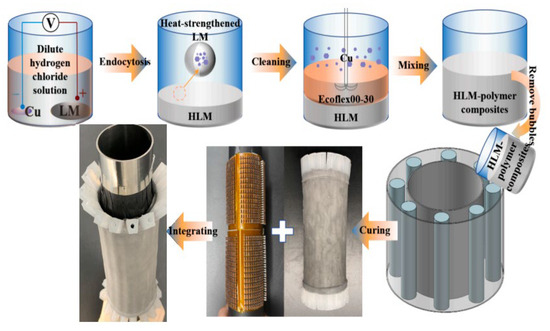
Figure 23.
Processing diagram of liquid-metal-based HSK [7] (reproduced with permission from Liu et al., Energy Conversion and Management, published by Elsevier, 2024).
In summary, passive cooling proves inadequate for automotive TEGs due to inefficient heat dissipation, where transient operations (e.g., idle-to-acceleration) induce significant temperature differentials, causing delayed cold-side response, TEM thermal runaway and stress-induced fracture. While PCM buffers thermal fluctuations to mitigate transient shock damage and heat pipe enhances thermal uniformity, water cooling dominates through forced-convection microchannels, enabling compact integration in exhaust-adjacent spaces, leveraging existing vehicle coolant systems with vibration-damping flexible tubing. Despite holding significant promise as a hybrid cooling solution, in theory, PCM–water–heat pipe synergistic systems face practical engineering constraints such as cost-effectiveness and spatial limitations. Consequently, liquid cooling remains the mainstream solution for automotive TEG. Moreover, for HSK in automotive TEG systems, three critical parameters govern performance: thermal resistance and power loss determine output and net power, while structural compatibility dictates cost. These parameters exhibit nonlinear coupling relationships, as demonstrated by studies [182,183], making multi-objective optimization essential to simultaneously address thermal resistance minimization, power consumption reduction, and structural cost optimization. Future advancements should focus on integrating lightweight 3D-printed topologies with novel composite materials coupled with dynamic thermal management algorithms to accelerate commercial viability.
5. Analysis and Optimization Methods
TEM performance is evaluated using the ZT value, conversion efficiency, mechanical reliability, and environmental adaptability, with assessment methods detailed in [21]. TEG prioritizes system conversion efficiency, net power, power density, economy, and environmental impact. Researchers employ theoretical analysis, numerical simulation, experimental testing, and hybrid approaches to optimize these metrics.
5.1. Theoretical Analysis
Figure 24 illustrates two common theoretical models: thermal resistance and equivalent circuit models. Thermal resistance models are categorized as 1D, 2D, or 3D and further divided into steady-state or transient based on input conditions. One-dimensional thermal resistance model neglects spatial variation in exhaust flow distribution, rendering them unsuitable for automotive TEG performance analysis.
Huang et al. [184] employed an iterative 2D thermal resistance model to evaluate annular TEG performance, incorporating temperature variations, temperature-dependent material properties, and local pressure drops. Chen et al. [128] also simplified the TEG system into a 2D thermal resistance model, analyzing air temperature and mass flow effects on convergence angles. The results showed that segmented convergent design improves net power by 12.5% and reduces backpressure loss by 14.8%. Luo et al. [155] combined 2D thermal resistance models with empirical formulas to calculate heat transfer coefficients and temperature distributions, validating model accuracy. Huang et al. [185] proposed a 3D thermal resistance model for rapid TEG optimization, dividing systems into unit cells with temperature positioned in centroid nodes. Experimental validation confirms that concentrated TEM placement in high-flow regions enhances power under non-uniform flow, while uniform TEM distribution performs better under steady flow.
An equivalent circuit model enables dynamic response under varying loads and temperature gradients, simplifying analysis but neglecting thermal inertia, time-domain responses, and temperature-dependent material properties. Lineykin et al. [186] developed a four-parameter equivalent circuit model for commercial TEMs under low-temperature gradients. Their study identified an optimal ratio of HSK-to-TEM thermal resistance for maximum output power, dependent on ZT value and ambient temperature.
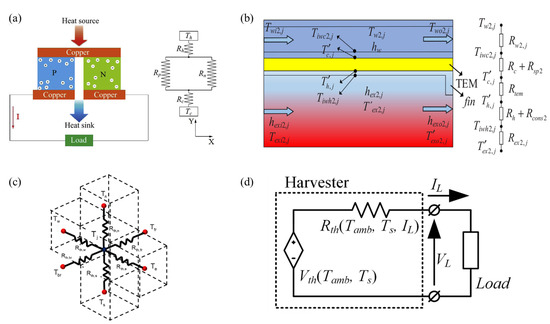

Figure 24.
Theoretical analysis models. (a) One-dimensional thermal resistance model [187] (reproduced with permission from Zhang et al., International Journal of Heat and Mass Transfer, published by Elsevier, 2016); (b) 2D thermal resistance model [155] (reproduced with permission from Luo et al., Applied Thermal Engineering, published by Elsevier, 2019); (c) 3D thermal resistance model [185] (reproduced with permission from Huang et al., Energy Conversion and Management, published by Elsevier, 2016); (d) equivalent circuit model [186] (reproduced with permission from Lineykin et al., Energy, published by Elsevier, 2020).
5.2. Numerical Simulation
Numerical simulation is a widely adopted approach [188,189,190], enabling complex geometry optimization. The finite element method (FEM), a subset of numerical simulation [191,192], is supported by commercial software for transient process analysis, extreme condition simulations, and multiphysics coupling, reducing reliance on costly experimental setups while accelerating development cycles [193,194]. However, FEM exhibits strong model dependency, with solution accuracy heavily influenced by mesh density and convergence challenges in multiphysics coupling, requiring user-adjusted solver strategies [195,196]. Common classifications include fluid–thermal, thermoelectric, and fluid–thermal–electrical models, with further categorization into steady-state or transient simulations based on time-dependent input conditions.
Thermal–electrical model is suitable for TEG systems in direct thermal contact with heat sources but inadequate for automotive applications. The fluid–thermal model calculates HEX temperatures, which are then input to the thermal–electrical model or thermal resistance model to calculate system output performance. These approaches neglect multiphysics coupling and temperature-dependent material properties. Fluid–thermal–electrical model integrates coupled multiphysics interactions for higher accuracy, albeit with substantial computational costs. Luo et al. [197] developed a transient model integrating fluid–thermal and thermal–electrical models, where exhaust flow rate and temperature served as inputs for fluid–thermal simulation, with resultant temperature subsequently driving TEG voltage calculation. In current research, the coupled fluid–thermal–electrical multiphysics model is the most widely used approach in automotive TEG studies [90,93,97]. Further numerical simulation details are provided in Ref. [17].
5.3. Experimental Testing
Experimental testing directly evaluates TEG performance under real operating conditions, particularly capturing dynamic variations in output power and efficiency. However, it incurs high resource consumption, elevated costs, prolonged testing durations, and data collection limitations while struggling to replicate extreme conditions [100]. Quan et al. [115] constructed a TEG test bench to experimentally analyze temperature distribution and power output under varying TEG parameters. Zhao et al. [171] compared intermediate fluid TEG with conventional design, measuring differences in output power, backpressure loss, and voltage uniformity under controlled exhaust temperatures and flow rate. Results demonstrated superior output power, efficiency, and pressure drop characteristics for intermediate fluid configurations. Karana et al. [198] experimentally investigated twisted fins in HEX, quantifying Nusselt number and friction factor variations across different fin geometries. Findings revealed increased friction factors with higher twist ratios and pitches, while twisted fins enhance turbulence intensity and Nusselt number.
5.4. Non-Algorithmic Hybrid Method
Non-algorithmic hybrid method, widely applied across disciplines [199,200], is also employed in automotive TEG structural optimization. Ni et al. [16] integrated numerical simulation with experimental testing: a 3D fluid–thermal–electrical model simulated temperature, flow velocity, heat flux, and voltage distributions, followed by engine bench tests measuring voltage, power, and thermal efficiency under varying loads and coolant flow rates. Liu et al. [7] combined experimental testing and numerical simulation, using a test rig to analyze exhaust parameters and connection mode impacts, then optimizing HSK geometry and validating thermal stability under deformation through numerical simulation. Li et al. [161] merged the thermal resistance model with experimental testing. The thermal resistance model identified limited cold-side thermal resistance reduction potential compared to hot-side. Subsequently, experimental testing quantified metal foam parameter effects on Nusselt number and backpressure loss.
5.5. Algorithm-Based Hybrid Method
The algorithm-based hybrid method enhances global search capabilities to avoid local optima [201,202], enabling multi-objective optimization of efficiency, weight, power, etc. While this approach reduces experimental costs and cycles [203], it requires high-quality data and cannot substitute experimental validation [204,205,206]. Artificial neural networks and multi-objective genetic algorithms are widely adopted across fields [207,208], including automotive TEG structural optimization.
Quan et al. [8] combined a fluid–thermal–electrical model with a crest porcupine optimizer to refine fin parameters. The optimized configuration yields 6.75% and 7.06% improvements in net power and efficiency, respectively. Marvão et al. [132] optimized fin and TEM parameters via thermal resistance model and gradient search, demonstrating significant net power gains from simultaneous component optimization. Su et al. [133] integrated numerical simulation with a multi-objective genetic algorithm to optimize fin length and thickness. Numerical simulation is used to build a dataset, the multi-objective genetic algorithm optimizing parameters. Qiang et al. [209] employed experimental testing and central composite design to assess fin parameters’ impacts on temperature and backpressure, followed by an archive-based microgenetic algorithm to optimize fin height, thickness, and spacing. The results indicated that transverse arrangements output better performance than longitudinal fin arrangements. Wang et al. [210] employed numerical simulation to assess the effects of HEX fin parameters (length, angle, spacing, thickness) on temperature uniformity and backpressure, followed by multi-island genetic algorithm optimization. Results indicated that fin length significantly influences temperature uniformity, while backpressure loss exhibits higher sensitivity to fin angle variations. Quan et al. [9] modeled TEG temperature distributions using a BP neural network with inputs including hot-side and cold-side temperature, current, and contact pressure. Subsequently, TEM connection topology is optimized via genetic algorithms to maximize TEG power output. Results demonstrated that the optimized configuration achieves a peak power of 179 W.
As described above, theoretical analysis simplifies the system through thermal resistance models and equivalent circuit models yet suffers from limitations such as oversimplified parameters, neglect of real-world operational complexities, and low computational accuracy. Numerical simulation relies on multiphysics coupling models, which integrate temperature-dependent material properties but face challenges, including high model dependency, computational resource intensity, and susceptibility to local optima. Experimental testing directly characterizes dynamic performance but is constrained by high costs and insufficient data dimensionality. The hybrid method, merging theoretical, simulation, and experimental approaches or integrating algorithms for multi-objective global optimization, has gradually emerged as the mainstream approach, with branches categorized as non-algorithm-driven and algorithm-driven. Future methods should focus on balancing “precision-efficiency-cost” synergies through strategies such as algorithm–experiment collaboration, model-data co-driving, and dynamic operational adaptation, thereby advancing interdisciplinary integration and intelligent algorithm fusion to accelerate the transition of automotive TEGs from laboratory prototypes to engineered solutions.
6. Future Prospects
Although numerous studies have demonstrated the feasibility of recovering automotive exhaust waste heat using thermoelectric material, with TEG prototypes achieving kW-level output power that confirms their effectiveness in improving vehicle fuel economy, significant challenges persist in commercializing automotive TEG. These challenges can be addressed through advancements in three key aspects: thermoelectric material, TEM performance, and TEG system conversion efficiency, as detailed below.
Current thermoelectric materials like Bi2Te3 and PbTe still lack sufficient ZT values for automotive waste heat recovery, requiring high-ZT material development alongside oxidation and corrosion-resistant solutions such as surface passivation coatings. TEM performance enhancement focuses on two paths: (1) structural optimization via finite element simulations to refine thermoelectric leg geometry and advanced welding techniques to halve interfacial contact resistance, complemented by flexible interconnects suppressing thermal resistance rise during cycling and (2) novel architectures like topology-optimized TEMs for exhaust temperature gradients and deformable substrate-based flexible TEMs to conform to curved surfaces, addressing planar design limitations.
Efficient heat transfer and thermal management remain the primary objectives of the TEG system. Transient exhaust temperature fluctuations and high flow velocity result in substantial unrecovered heat, with current system efficiencies below 5%. Advanced HEXs incorporating heat pipe or PCM could enhance heat recovery while stabilizing TEM temperature differential and protecting against thermal shock. HSK optimization requires innovative channel designs and high-performance cooling media. Additionally, system integration should account for compact underbody space constraints through lightweight strategies such as 3D-printed topology-optimized structure and carbon fiber-reinforced ceramic substrate. Finally, digital twin technology, by integrating onboard sensors with cloud-based models, constructs real-time virtual replicas to simulate vehicle operating conditions and mirror physical device states, enabling predictive health monitoring and full lifecycle management. The convergence of AI, machine learning, and digital twin technology will drive the rapid commercialization of TEG systems in automotive applications.
7. Conclusions
This review has systematically investigated geometric configurations of TEM, HEX, and HSK in TEG, along with methods for analyzing and optimizing TEG performance. The principal findings are summarized as follows:
- (1)
- Current TEG designs employ serial development, inadequately accounting for the coupling mechanisms among the TEM, HEX, and HSK. Future efforts should develop collaborative optimization to achieve dynamic multi-objective equilibrium between structural reliability and energy gains under multiphysics coupling.
- (2)
- Thermoelectric materials achieve ZT improvements via interface and nanostructure engineering. TEM designs include segmented and non-segmented configurations: segmented ones optimize material combinations, while non-segmented ones enhance thermal stress distribution. Multi-stage TEMs boost efficiency through series and parallel arrangements. Cuboid structures dominate manufacturability, whereas unconventional geometries excel in specific thermal conditions.
- (3)
- HEX designs prioritize external and internal configurations. Plate HEX features compactness and modularity, while polygonal design maximizes heat transfer areas for TEM integration. Annular configuration suits curved exhaust pipe but faces modularity constraints. Internally, the fin expands the surface and induces turbulence, the baffle optimizes localized flow, and metal foam balances efficiency and backpressure loss. Heat pipe enables phase-change heat transfer, synergizing with PCM to stabilize temperature through latent heat absorption.
- (4)
- The HSKs are classified as active, passive, or hybrid systems based on TEG requirements. Active HSKs utilize forced convection, with water cooling dominating automotive TEG, while hybrid system integrates heat pipe, fin, or combined cooling systems. Key optimizations include advanced coolant selection, flow channel redesign, and geometric modifications.
- (5)
- Optimization methods include theoretical analysis, numerical simulation, experimental testing, and hybrid approaches, requiring strategies to balance computational efficiency and accuracy based on system complexity and resource availability. The 2D/3D thermal resistance models, fluid–thermal–electric coupled model, and algorithm-based hybrid method better suit structural optimization.
- (6)
- While research on automotive TEG has achieved notable progress, the practical application remains predominantly confined to laboratory-scale demonstration. To realize commercial viability, there is an urgent need to establish systematic design standards adaptable to diverse vehicle platforms and develop universal optimization methodologies, thereby accelerating industrial-scale deployment.
Author Contributions
Conceptualization, Y.W. and R.W.; methodology, R.C.; software, Z.S. and D.S.; validation, R.D. and D.S.; investigation, Q.Y. and X.M.; resources, Q.Y. and Z.S.; data curation, R.C.; visualization, R.D.; supervision, R.W.; funding acquisition, Y.W. and R.W. All authors have read and agreed to the published version of the manuscript.
Funding
This research was funded by the National Natural Science Foundation of China (Grant No. 52472410), International Science and Technology Cooperation Project of Changzhou (Grant No. CZ20240010) and Natural Science Research Key Project of Colleges and Universities of Anhui Province (Grant No. 2024AH051398).
Data Availability Statement
No new data were created or analyzed in this study.
Conflicts of Interest
The authors declare no conflicts of interest.
Nomenclature
| Symbols | |||
| V | exhaust gas flow velocity | P | maximum output power |
| T | inlet temperature | Pnet | maximum net power |
| flow rate | η | conversion efficiency | |
| mass flow rate | ηnet | net conversion efficiency | |
| Abbreviations | |||
| TEG | thermoelectric generator | TWC | three-way catalyst |
| TEM | thermoelectric module | PPI | pores per inch |
| HEX | heat exchanger | PCM | phase-change material |
| HSK | heat sink | ||
References
- Bei, X.; Yu, X.; Li, D.; Sun, Q.; Yu, Y.; Wang, Y.; Okonkwo, C.E.; Zhou, C. Heat source replacement strategy using catalytic infrared: A future for energy saving drying of fruits and vegetables. J. Food Sci. 2023, 88, 4827–4839. [Google Scholar] [CrossRef] [PubMed]
- Zhu, Z.; Yang, Y.; Wang, D.; Cai, Y.; Lai, L. Energy Saving Performance of Agricultural Tractor Equipped with Mechanic-Electronic-Hydraulic Powertrain System. Agriculture 2022, 12, 436. [Google Scholar] [CrossRef]
- Zhu, Z.; Chai, X.; Xu, L.; Quan, L.; Yuan, C.; Tian, S. Design and performance of a distributed electric drive system for a series hybrid electric combine harvester. Biosyst. Eng. 2023, 236, 160–174. [Google Scholar] [CrossRef]
- Zhu, Z.; Zeng, L.; Chen, L.; Zou, R.; Cai, Y. Fuzzy Adaptive Energy Management Strategy for a Hybrid Agricultural Tractor Equipped with HMCVT. Agriculture 2022, 12, 1986. [Google Scholar] [CrossRef]
- Liu, J.; Xia, C.; Jiang, D.; Shang, G.; Han, J.; Sun, Y. Determination and Application of Maximum Efficiency Curve of Crawler Electric Tractor Motors. Math Probl. Eng. 2021, 2021, 1310926. [Google Scholar] [CrossRef]
- Luo, D.; Yu, Y.; Yan, Y.; Chen, W.; Cao, B. Increasing power densities in a thermoelectric generator by stacking and incorporating dual heat pipes. Device 2024, 2, 100435. [Google Scholar] [CrossRef]
- Liu, C.; Wang, Q.; Wang, Y.; Wang, Z.; Han, X.; Zhou, Q.; He, Z.; Yin, T. Automobile exhaust flexible thermoelectric harvester enabled by liquid metal-based heatsink. Energy Convers. Manag. 2024, 316, 118826. [Google Scholar] [CrossRef]
- Quan, R.; Zhou, Y.; Yao, S.; Wan, H.; Chang, Y. Improving the performance of a polygonal automobile exhaust thermoelectric generator with a crested porcupine optimizer. Appl. Therm. Eng. 2025, 268, 125946. [Google Scholar] [CrossRef]
- Quan, R.; Tang, X.; Quan, S.; Huang, L. A Novel Optimization Method for the Electric Topology of Thermoelectric Modules Used in an Automobile Exhaust Thermoelectric Generator. J. Electron. Mater. 2013, 42, 1469–1475. [Google Scholar] [CrossRef]
- Tang, X.; Zhang, K.; Tan, S.; Peng, X.; Long, M. Effect of quantum interference and doping on thermoelectric performance in GYNR and GYCNNR molecular junctions with PBCF-graphene nanoribbon electrodes. Chem. Phys. 2025, 591, 112585. [Google Scholar] [CrossRef]
- Nguyen, T.H.; Nguyen, V.Q.; Van Cuong, P.; Phan, N.N.; Park, J.H.; Park, S.; Cho, S. Enhancing the thermoelectric performance of Bi2Se3 single crystals via Sn doping. Solid State Commun. 2025, 397, 115849. [Google Scholar] [CrossRef]
- Ju, H.; Park, D.; Kim, M.; Kim, J. Copper telluride with manipulated carrier concentrations for high-performance solid-state thermoelectrics. J. Mater Sci. Technol. 2022, 129, 190–195. [Google Scholar] [CrossRef]
- Luo, D.; Zhang, H.; Cao, J.; Yan, Y.; Cao, B. Numerical investigation and optimization of a hexagonal thermoelectric generator with diverging fins for exhaust waste heat recovery. Energy 2024, 301, 131756. [Google Scholar] [CrossRef]
- Yan, S.; Moria, H.; Asaadi, S.; Sadighi Dizaji, H.; Khalilarya, S.; Jermsittiparsert, K. Performance and profit analysis of thermoelectric power generators mounted on channels with different cross-sectional shapes. Appl. Therm. Eng. 2020, 176, 115455. [Google Scholar] [CrossRef]
- Liu, J.; Xu, M.; Guo, W.; Xi, W.; Liu, C.; Sunden, B. Flow and heat transfer mechanism of a regenerative cooling channel mounted with pin-fins using supercritical CO2 as coolant. Int. J. Therm. Sci. 2025, 208, 109425. [Google Scholar] [CrossRef]
- Ni, P.; Hua, R.; Jiang, H.; Wang, X.; Zhang, X.; Li, X. Thermal flow and thermoelectricity characteristics in a sandwich flat plate thermoelectric power generation device under diesel engine exhaust conditions. Energy 2024, 308, 132815. [Google Scholar] [CrossRef]
- Luo, D.; Liu, Z.; Yan, Y.; Li, Y.; Wang, R.; Zhang, L.; Yang, X. Recent advances in modeling and simulation of thermoelectric power generation. Energy Convers. Manag. 2022, 273, 116389. [Google Scholar] [CrossRef]
- Bhakta, S.; Kundu, B. A Review of Thermoelectric Generators in Automobile Waste Heat Recovery Systems for Improving Energy Utilization. Energies 2024, 17, 1016. [Google Scholar] [CrossRef]
- Ochieng, A.O.; Megahed, T.F.; Ookawara, S.; Hassan, H. Comprehensive review in waste heat recovery in different thermal energy-consuming processes using thermoelectric generators for electrical power generation. Process. Saf. Environ. 2022, 162, 134–154. [Google Scholar] [CrossRef]
- Tohidi, F.; Ghazanfari Holagh, S.; Chitsaz, A. Thermoelectric Generators: A comprehensive review of characteristics and applications. Appl. Therm. Eng. 2022, 201, 117793. [Google Scholar] [CrossRef]
- Shittu, S.; Li, G.; Zhao, X.; Ma, X. Review of thermoelectric geometry and structure optimization for performance enhancement. Appl. Energy 2020, 268, 115075. [Google Scholar] [CrossRef]
- Shen, Z.; Tian, L.; Liu, X. Automotive exhaust thermoelectric generators: Current status, challenges and future prospects. Energy Convers. Manag. 2019, 195, 1138–1173. [Google Scholar] [CrossRef]
- Luo, D.; Li, Y.; Yan, Y.; Hu, X.; Fan, X.; Chen, W.; Ren, Y.; Cao, B. Realizing ultrahigh ZT value and efficiency of the Bi2Te3 thermoelectric module by periodic heating. Energy Convers. Manag. 2023, 296, 117669. [Google Scholar] [CrossRef]
- Zhao, K.; Liu, C.; Shao, T.; Fan, Y.; Chen, R.; Pan, X. Enhanced thermoelectric performance of Bi2Te3 by carbon nanotubes and silicate aerogel co-doping toward ocean energy harvesting. Mater. Today Sustain. 2023, 23, 100476. [Google Scholar] [CrossRef]
- Lv, M.; Wu, N.; Fan, X.; Zheng, W.; Singh, D.J. Bi2X (X = Ge, Sn) monolayers: Promising thermoelectric materials with ultra-low thermal conductivity. Mater. Today Phys. 2024, 49, 101594. [Google Scholar] [CrossRef]
- Ding, Y.; Liang, X.; Luo, L.; Hu, W.; Long, Y.; Song, Y.; Kang, K. Effect of lattice defects on electronic structure and thermoelectric properties of two- dimensional WS2 materials. Mater. Today Commun. 2023, 37, 107449. [Google Scholar] [CrossRef]
- Priyambada, A.; Mohanty, A.; Parida, P. Effect of vacancies on structural, electronic, elastic, and thermoelectric properties of CdIn2Se4 defect chalcopyrite-type semiconductor: An ab-initio approach. Mater. Today Commun. 2023, 37, 107338. [Google Scholar] [CrossRef]
- Aaouita, K.E.; Mediane, N.; Goumrhar, F.; Drissi, L.B.; Laamara, R.A. Enhanced spintronic and thermoelectric performance in vanadium-doped CaTiO3: An ab-initio study. Comput. Condens. Matter 2025, 42, e00999. [Google Scholar] [CrossRef]
- Qiu, W.; He, H.; Wang, Z.; Hu, Q.; Cui, X.; Wang, Z.; Zhang, Y.; Gu, L.; Yang, L.; Sun, Y.; et al. Enhancing the figure of merit of n-type PbTe materials through multi-scale graphene induced interfacial engineering. Nano Today 2021, 39, 101176. [Google Scholar] [CrossRef]
- Wei, J.; Lv, E.; Shi, Z.; Jiang, Z.; Sheng, L.; Gao, W.; Li, X.; Liu, Y. Enhancing the thermoelectric characteristics of thermoelectric cement matrix composites by (Ca0.87Ag0.1La0.03)3Co4O9 binary metal oxide. Ceram. Int. 2023, 49, 37829–37836. [Google Scholar] [CrossRef]
- Amirkhizi, P.; Madre, M.A.; Dura, O.J.; Torres, M.A.; Sotelo, A.; Kovalevsky, A.V.; Rasekh, S. Enhancing thermoelectric performance of CaMnO3 through a Y- and La- dual-doping strategy. Ceram. Int. 2025, 51, 9421–9428. [Google Scholar] [CrossRef]
- Wang, Y.; Wei, J.; Miao, Z.; Zhou, Y.; Guo, Y.; Li, X.; Zhang, H. Excellent thermoelectric properties of P-type cement-based composites through a universal defect engineering approach for large-scale energy harvesting. Constr. Build. Mater. 2022, 351, 128967. [Google Scholar] [CrossRef]
- Benkaddour, I.; Haddou, A.; Khachai, Y.A.; Baki, N.; Chiker, F.; Khachai, H.; Khenata, R.; Metadjer, N.; Bin-Omran, S.; Shankar, A.; et al. Exploring optoelectronic, optical thin films, mechanical and thermal transport properties of bromide double perovskites Rb2Ag(Ga/In)Br6 for photovoltaic and thermoelectric applications. Mat. Sci. Semicon. Proc. 2025, 185, 108974. [Google Scholar] [CrossRef]
- Irfan, M.; Ibrahim, F.A.; Hamdy, M.S.; Issa, S.A.M.; Zakaly, H.M.H. First principles investigations of linear and nonlinear optical, radiation shielding and thermoelectric properties of the non-centrosymmetric Ba-based chalcogenides Ba2In2X5 (X = S, Te). Mat. Sci. Semicon. Proc. 2025, 185, 108957. [Google Scholar] [CrossRef]
- Mehmood, S.; Ali, Z.; Altuijri, R.; Abu El Maati, L.; Khan, S.R.; Trukhanov, S.V.; Zubar, T.I.; Sayyed, M.I.; Tishkevich, D.I.; Trukhanov, A.V. First-principles study of the rare earth anti-TH3P4 type zintles for opto-electronic and thermoelectric applications. Phys. B Condensed. Matter 2023, 670, 415353. [Google Scholar] [CrossRef]
- Zhang, Y.; Yang, C.; Lu, R.; Zhang, S.; Tang, B. Flexible thermoelectric device with excellent durability towards self-powered light intensity detection. Compos. Sci. Technol. 2022, 227, 109616. [Google Scholar] [CrossRef]
- Tang, D.; Dan, M.; Zhang, Y. High performance piezotronic thermoelectric devices based on zigzag MoS2 nanoribbon. Nano Energy 2022, 104, 107888. [Google Scholar] [CrossRef]
- Xiang, J.; Dai, B.; Zhang, X.; Guo, H.; Cheng, W.; Ge, N. High thermoelectric performance of intrinsic few-layers T-HfSe2. Mater. Today Commun. 2022, 33, 104789. [Google Scholar] [CrossRef]
- Wehbe, M.; Dgheim, J.; Sassine, E. House electrical generation using thermoelectric cinder block: Case study on Lebanese hollow block. Sustain. Energy Techn. 2022, 50, 101815. [Google Scholar] [CrossRef]
- Dudnikov, V.A.; Orlov, Y.S.; Vereshchagin, S.N.; Belov, A.A.; Solovyov, L.A.; Borus, A.A.; Zharkov, S.M.; Zeer, G.M.; Ustyuzhanin, Y.N.; Volochaev, M.N.; et al. Improving of thermoelectric figure of merit in Sr0.925Dy0.075 TiO3 ceramics. Ceram. Int. 2024, 50, 55026–55033. [Google Scholar] [CrossRef]
- Wu, T.; Shi, X.; Deng, Y.; Liu, Y.; Zhu, M.; Liu, W.; Li, M.; Yue, F.; Huang, P.; Chen, Z.; et al. Incorporating graphene quantum dots boosts thermoelectric performance of PEDOT:PSS films. Chem. Eng. J. 2025, 506, 160219. [Google Scholar] [CrossRef]
- Aldaghfag, S.A.; Aziz, A.; Younas, A.; Yaseen, M.; Murtaza, A.; Hegazy, H.H. Investigation of electronic, optical and thermoelectric features of X2ScAgCl6 (X=K, Na) double perovskites for renewable energy applications. J. Solid State Chem. 2022, 312, 123179. [Google Scholar] [CrossRef]
- Hamid, M.; Faizan, M.; Alrebdi, T.A.; Shaheen, K.; Khan, S.H. Computational study of the lattice type, band structure, and thermoelectric properties of LiSbX2 (X = S, Se, Te). Chem. Phys. 2025, 591, 112600. [Google Scholar] [CrossRef]
- Pham, A.T.T.; Le, O.K.T.; Phan, T.T.T.; Hoang, D.V.; Nguyen, T.H.; Le, N.D.; Phan, T.B.; Tran, V.C. Enhancing transparent thermoelectric properties of Sb-doped ZnO thin films via controlled deposition temperature. Vacuum 2022, 202, 111137. [Google Scholar] [CrossRef]
- Darhi, Z.; Rawat, A.; Pandey, R.; Elfarh, L. First-principles study of thermoelectric properties of the bulk and Sb-doped orthorhombic ZnAs and CdAs. Mat. Sci. Semicon. Proc. 2025, 185, 108896. [Google Scholar] [CrossRef]
- Poon, S.J. Half Heusler compounds: Promising materials for mid-to-high temperature thermoelectric conversion. J. Phys. D Appl. Phys. 2019, 49, 493001. [Google Scholar] [CrossRef]
- Azam, K.; Akhtar, S.; Gong, Y.Y.; Routledge, M.N.; Ismail, A.; Oliveira, C.A.F.; Iqbal, S.Z.; Ali, H. Evaluation of the impact of activated carbon-based filtration system on the concentration of aflatoxins and selected heavy metals in roasted coffee. Food Control. 2021, 121, 107583. [Google Scholar] [CrossRef]
- Yuan, J.; Zhu, Y.; Wang, J.; Gan, L.; He, M.; Zhang, T.; Li, P.; Qiu, F. Preparation and application of Mg–Al composite oxide/coconut shell carbon fiber for effective removal of phosphorus from domestic sewage. Food Bioprod. Process. 2021, 126, 293–304. [Google Scholar] [CrossRef]
- Wang, X.; Xu, Y.; Li, Y.; Li, Y.; Li, Z.; Zhang, W.; Zou, X.; Shi, J.; Huang, X.; Liu, C.; et al. Rapid detection of cadmium ions in meat by a multi-walled carbon nanotubes enhanced metal-organic framework modified electrochemical sensor. Food Chem. 2021, 357, 129762. [Google Scholar] [CrossRef]
- Li, W.; Hu, X.; Li, Q.; Shi, Y.; Zhai, X.; Xu, Y.; Li, Z.; Huang, X.; Wang, X.; Shi, J.; et al. Copper nanoclusters @ nitrogen-doped carbon quantum dots-based ratiometric fluorescence probe for lead (II) ions detection in porphyra. Food Chem. 2020, 320, 126623. [Google Scholar] [CrossRef]
- Liang, N.; Hu, X.; Li, W.; Mwakosya, A.W.; Guo, Z.; Xu, Y.; Huang, X.; Li, Z.; Zhang, X.; Zou, X.; et al. Fluorescence and colorimetric dual-mode sensor for visual detection of malathion in cabbage based on carbon quantum dots and gold nanoparticles. Food Chem. 2021, 343, 128494. [Google Scholar] [CrossRef]
- He, X.; Gu, J.; Hao, Y.; Zheng, M.; Wang, L.; Yu, J.; Qin, X. Continuous manufacture of stretchable and integratable thermoelectric nanofiber yarn for human body energy harvesting and self-powered motion detection. Chem. Eng. J. 2022, 450, 137937. [Google Scholar] [CrossRef]
- Fan, X.; Zhang, X.; Zhang, X.; Shiu, B.; Lin, J.; Lou, C.; Li, T. Energy filtering effect of flexible organic/inorganic nanocomposite thermoelectric fabrics to harvest human heat and solar energy. Polymer 2023, 283, 126224. [Google Scholar] [CrossRef]
- Cao, J.; Tan, X.Y.; Jia, N.; Zheng, J.; Chien, S.W.; Ng, H.K.; Tan, C.K.I.; Liu, H.; Zhu, Q.; Wang, S.; et al. Designing good compatibility factor in segmented Bi0.5Sb1.5Te3—GeTe thermoelectrics for high power conversion efficiency. Nano Energy 2022, 96, 107147. [Google Scholar] [CrossRef]
- Li, J.; Sun, Y.; Shi, W.; Li, Y.; Zou, Y.; Zhang, H. Fabrication, characterization, and in vitro digestion of gelatin/gluten oleogels from thermally crosslinked electrospun short fiber aerogel templates. Food Chem. 2024, 454, 139804. [Google Scholar] [CrossRef]
- Ren, M.; Fakayode, O.A.; Kong, F.; Zhou, C.; Chen, L.; Fan, X.; Liang, J.; Li, H. Characterization of cellulose nanocrystals prepared by different delignification methods and application of ultra-light, hydrophobic aerogels as oil absorbent in food systems. Ind. Crop. Prod. 2023, 197, 116653. [Google Scholar] [CrossRef]
- Chen, Y.; Chen, H.; Dai, Y.; Xiao, J.; Qiu, F.; Zhang, T. Honeycomb porous regenerated cellulose aerogel films with enhanced thermal dissipation for agricultural mulch application. Food Bioprod. Process. 2024, 147, 418–427. [Google Scholar] [CrossRef]
- Jing, Z.; Ding, J.; Zhang, T.; Yang, D.; Qiu, F.; Chen, Q.; Xu, J. Flexible, versatility and superhydrophobic biomass carbon aerogels derived from corn bracts for efficient oil/water separation. Food Bioprod. Process. 2019, 115, 134–142. [Google Scholar] [CrossRef]
- Maksymuk, M.; Dzundza, B.; Matkivsky, O.; Horichok, I.; Shneck, R.; Dashevsky, Z. Development of the high performance thermoelectric unicouple based on Bi2Te3 compounds. J. Power Sources 2022, 530, 231301. [Google Scholar] [CrossRef]
- Alghamdi, N.; El-Shamy, A.G. A review on the recent progress in thermoelectric aerogels: Fabrications, generators, marine harvesting, sensors, and thermocells applications. Synth. Met. 2025, 310, 117776. [Google Scholar] [CrossRef]
- Cui, X.; Chen, X.; Gao, Z. Research on the power generation performance and optimization of thermoelectric generators for recycling remaining cold energy. Energy 2024, 299, 131422. [Google Scholar] [CrossRef]
- Ge, M.; Zhao, Y.; Li, Y.; He, W.; Xie, L.; Zhao, Y. Structural optimization of thermoelectric modules in a concentration photovoltaic–thermoelectric hybrid system. Energy 2022, 244, 123202. [Google Scholar] [CrossRef]
- Yilbas, B.S.; Sahin, A.Z. Thermoelectric device and optimum external load parameter and slenderness ratio. Energy 2010, 35, 5380–5384. [Google Scholar] [CrossRef]
- Fan, L.; Zhang, G.; Wang, R.; Jiao, K. A comprehensive and time-efficient model for determination of thermoelectric generator length and cross-section area. Energy Convers. Manag. 2016, 122, 85–94. [Google Scholar] [CrossRef]
- Harish, S.; Sivaprahasam, D.; Jayachandran, B.; Gopalan, R.; Sundararajan, G. Performance of bismuth telluride modules under thermal cycling in an automotive exhaust thermoelectric generator. Energy Convers. Manag. 2021, 232, 113900. [Google Scholar] [CrossRef]
- Kim, H.S.; Kikuchi, K.; Itoh, T.; Iida, T.; Taya, M. Design of segmented thermoelectric generator based on cost-effective and light-weight thermoelectric alloys. Mater. Sci. Eng. B 2014, 185, 45–52. [Google Scholar] [CrossRef]
- Shittu, S.; Li, G.; Zhao, X.; Ma, X.; Akhlaghi, Y.G.; Ayodele, E. High performance and thermal stress analysis of a segmented annular thermoelectric generator. Energy Convers. Manag. 2019, 184, 180–193. [Google Scholar] [CrossRef]
- He, H.; Xie, Y.; Zuo, Q.; Chen, W.; Shen, Z.; Ma, Y.; Zhang, H.; Zhu, G.; Ouyang, Y. Optimization analysis for thermoelectric performance improvement of biconical segmented annular thermoelectric generator. Energy 2024, 306, 132397. [Google Scholar] [CrossRef]
- Erturun, U.; Erermis, K.; Mossi, K. Effect of various leg geometries on thermo-mechanical and power generation performance of thermoelectric devices. Appl. Therm. Eng. 2014, 73, 128–141. [Google Scholar] [CrossRef]
- Zhang, Y.; Guo, K.; Wang, C.; Zhang, J.; Wang, Y.; Xi, T.; Su, G.H.; Qiu, S. Artificial neural network for geometric design and optimization of three-stage segmented thermoelectric generators. Appl. Therm. Eng. 2024, 256, 124077. [Google Scholar] [CrossRef]
- Wu, Y.; Yang, J.; Chen, S.; Zuo, L. Thermo-element geometry optimization for high thermoelectric efficiency. Energy 2018, 147, 672–680. [Google Scholar] [CrossRef]
- Oki, S.; Natsui, S.; Suzuki, R.O. Performance Analysis of Thermoelectric Modules Consisting of Square Truncated Pyramid Elements Under Constant Heat Flux. J. Electron. Mater. 2018, 47, 3288–3297. [Google Scholar] [CrossRef]
- Luo, D.; Liu, Z.; Cao, J.; Yan, Y.; Cao, B. Performance investigation and optimization of an L-type thermoelectric generator. Energy 2024, 307, 132768. [Google Scholar] [CrossRef]
- Wang, R.; Meng, Z.; Luo, D.; Yu, W.; Zhou, W. A Comprehensive Study on X-Type Thermoelectric Generator Modules. J. Electron. Mater. 2020, 49, 4343–4354. [Google Scholar] [CrossRef]
- Ibeagwu, O.I. Modelling and comprehensive analysis of TEGs with diverse variable leg geometry. Energy 2019, 180, 90–106. [Google Scholar] [CrossRef]
- Luo, D.; Zhang, H.; Cao, J.; Yan, Y.; Cao, B. Innovative design of an annular thermoelectric generator for enhanced automotive waste heat recovery. Energy Convers. Manag. 2024, 313, 118584. [Google Scholar] [CrossRef]
- Zhou, X.; M Abed, A.; Chaturvedi, R.; Abdullaeva, B.S.; Shawabkeh, A.; Fouad, Y.; Riaz, F. A novel thermal management system for a cylindrical battery based on tubular thermoelectric generator. Case Stud. Therm. Eng. 2024, 59, 104585. [Google Scholar] [CrossRef]
- Luo, D.; Liu, Z.; Cao, J.; Yan, Y. Feasibility and parametric study of a groove-type thermoelectric generator under multiphysics field conditions. Appl. Therm. Eng. 2025, 259, 124972. [Google Scholar] [CrossRef]
- Liu, K.; Tang, X.; Liu, Y.; Xu, Z.; Yuan, Z.; Li, J.; Zhang, Z. Preparation and optimization of miniaturized radioisotope thermoelectric generator based on concentric filament architecture. J. Power Sources 2018, 407, 14–22. [Google Scholar] [CrossRef]
- Niu, Z.; Yu, S.; Diao, H.; Li, Q.; Jiao, K.; Du, Q.; Tian, H.; Shu, G. Elucidating modeling aspects of thermoelectric generator. Int. J. Heat Mass Tran. 2015, 85, 12–32. [Google Scholar] [CrossRef]
- Shi, Y.; Mei, D.; Yao, Z.; Wang, Y.; Liu, H.; Chen, Z. Nominal power density analysis of thermoelectric pins with non-constant cross sections. Energy Convers. Manag. 2015, 97, 1–6. [Google Scholar] [CrossRef]
- Bian, M.; Xu, Z.; Tang, X.; Chen, C.; Jia, H. Tri-objective and multi-parameter geometric optimization of two-stage radioisotope thermoelectric generator based on NSGA-II. Appl. Therm. Eng. 2025, 258, 124685. [Google Scholar] [CrossRef]
- Long, Y.; Yin, E.; Li, Q.; Yang, S. Experimental study on a solar thermoelectric power generation system under non-uniform irradiation. Appl. Therm. Eng. 2024, 256, 124101. [Google Scholar] [CrossRef]
- Liang, X.; Sun, X.; Tian, H.; Shu, G.; Wang, Y.; Wang, X. Comparison and parameter optimization of a two-stage thermoelectric generator using high temperature exhaust of internal combustion engine. Appl. Energy 2014, 130, 190–199. [Google Scholar] [CrossRef]
- Zhang, H.; Xu, H.; Chen, B.; Dong, F.; Ni, M. Two-stage thermoelectric generators for waste heat recovery from solid oxide fuel cells. Energy 2017, 132, 280–288. [Google Scholar] [CrossRef]
- Zhai, X.; Sun, Y.; Cen, S.; Wang, X.; Zhang, J.; Yang, Z.; Li, Y.; Wang, X.; Zhou, C.; Arslan, M.; et al. Anthocyanins-encapsulated 3D-printable bigels: A colorimetric and leaching-resistant volatile amines sensor for intelligent food packaging. Food Hydrocoll. 2022, 133, 107989. [Google Scholar] [CrossRef]
- Guo, Z.; Li, Z.; Cen, S.; Liang, N.; Shi, J.; Huang, X.; Zou, X. Preparation of Pangasius hypophthalmus protein-stabilized pickering emulsions and 3D printing application. J. Food Eng. 2023, 341, 111333. [Google Scholar] [CrossRef]
- Hu, L.; Ding, F.; Liu, W.; Cheng, Y.; Zhu, J.; Ma, L.; Zhang, Y.; Wang, H. Effect of enzymatic-ultrasonic hydrolyzed chitooligosaccharide on rheology of gelatin incorporated yogurt and 3D printing. Food Hydrocoll. 2022, 132, 107851. [Google Scholar] [CrossRef]
- Ji, D.; Hu, S.; Feng, Y.; Qin, J.; Yin, Z.; Romagnoli, A.; Zhao, J.; Qian, H. Geometry optimization of solar thermoelectric generator under different operating conditions via Taguchi method. Energy Convers. Manag. 2021, 238, 114158. [Google Scholar] [CrossRef]
- Chen, J.; Wang, R.; Ding, R.; Luo, D. Matching design and numerical optimization of automotive thermoelectric generator system applied to range-extended electric vehicle. Appl. Energy 2024, 370, 123637. [Google Scholar] [CrossRef]
- Luo, D.; Wu, Z.; Yan, Y.; Ji, D.; Cheng, Z.; Wang, R.; Li, Y.; Yang, X. Optimal design of a heat exchanger for automotive thermoelectric generator systems applied to a passenger car. Appl. Therm. Eng. 2023, 227, 120360. [Google Scholar] [CrossRef]
- Chen, J.; Wang, R.; Ding, R.; Luo, D. Numerical study of a novel automotive thermoelectric generator system equipped with segmented converging heat exchanger. Case Stud. Therm. Eng. 2024, 57, 104367. [Google Scholar] [CrossRef]
- Luo, D.; Yang, S.; Yan, Y.; Cao, J.; Cao, B. Performance improvement of the automotive thermoelectric generator by extending the hot side area of the heat exchanger through heat pipes. Energy Convers. Manag. 2024, 310, 118472. [Google Scholar] [CrossRef]
- Wang, T.; Luan, W.; Liu, T.; Tu, S.; Yan, J. Performance enhancement of thermoelectric waste heat recovery system by using metal foam inserts. Energy Convers. Manag. 2016, 124, 13–19. [Google Scholar] [CrossRef]
- Luo, D.; Wang, R.; Yan, Y.; Sun, Z.; Zhou, W.; Ding, R. Comparison of different fluid-thermal-electric multiphysics modeling approaches for thermoelectric generator systems. Renew. Energy 2021, 180, 1266–1277. [Google Scholar] [CrossRef]
- Ge, M.; Li, Z.; Zhao, Y.; Xuan, Z.; Li, Y.; Zhao, Y. Experimental study of thermoelectric generator with different numbers of modules for waste heat recovery. Appl. Energy 2022, 322, 119523. [Google Scholar] [CrossRef]
- Zhao, Y.; Lu, M.; Li, Y.; Wang, Y.; Ge, M. Numerical investigation of an exhaust thermoelectric generator with a perforated plate. Energy 2023, 263, 125776. [Google Scholar] [CrossRef]
- Lan, S.; Yang, Z.; Chen, R.; Stobart, R. A dynamic model for thermoelectric generator applied to vehicle waste heat recovery. Appl. Energy 2018, 210, 327–338. [Google Scholar] [CrossRef]
- Risseh, A.E.; Nee, H.; Goupil, C. Electrical Power Conditioning System for Thermoelectric Waste Heat Recovery in Commercial Vehicles. IEEE Trans. Transp. Electrif. 2018, 4, 548–562. [Google Scholar] [CrossRef]
- Lan, S.; Stobart, R.; Chen, R. Performance comparison of a thermoelectric generator applied in conventional vehicles and extended-range electric vehicles. Energy Convers. Manag. 2022, 266, 115791. [Google Scholar] [CrossRef]
- Massaguer, A.; Massaguer, E.; Comamala, M.; Pujol, T.; Montoro, L.; Cardenas, M.D.; Carbonell, D.; Bueno, A.J. Transient behavior under a normalized driving cycle of an automotive thermoelectric generator. Appl. Energy 2017, 206, 1282–1296. [Google Scholar] [CrossRef]
- Wojciechowski, K.T.; Schmidt, M.; Zybala, R.; Merkisz, J.; Fuć, P.; Lijewski, P. Comparison of Waste Heat Recovery from the Exhaust of a Spark Ignition and a Diesel Engine. J. Electron. Mater. 2010, 39, 2034–2038. [Google Scholar] [CrossRef]
- Frobenius, F.; Gaiser, G.; Rusche, U.; Weller, B. Thermoelectric Generators for the Integration into Automotive Exhaust Systems for Passenger Cars and Commercial Vehicles. J. Electron. Mater. 2016, 45, 1433–1440. [Google Scholar] [CrossRef]
- Lu, X.; Yu, X.; Qu, Z.; Wang, Q.; Ma, T. Experimental investigation on thermoelectric generator with non-uniform hot-side heat exchanger for waste heat recovery. Energy Convers. Manag. 2017, 150, 403–414. [Google Scholar] [CrossRef]
- Wang, X.; Li, B.; Yan, Y.; Liu, S.; Li, J. A study on heat transfer enhancement in the radial direction of gas flow for thermoelectric power generation. Appl. Therm. Eng. 2016, 102, 176–183. [Google Scholar] [CrossRef]
- Zhang, Y.; Cleary, M.; Wang, X.; Kempf, N.; Schoensee, L.; Yang, J.; Joshi, G.; Meda, L. High-temperature and high-power-density nanostructured thermoelectric generator for automotive waste heat recovery. Energy Convers. Manag. 2015, 105, 946–950. [Google Scholar] [CrossRef]
- Fernández-Yañez, P.; Armas, O.; Capetillo, A.; Martínez-Martínez, S. Thermal analysis of a thermoelectric generator for light-duty diesel engines. Appl. Energy 2018, 226, 690–702. [Google Scholar] [CrossRef]
- Luo, D.; Wang, R.; Yu, W.; Zhou, W. A numerical study on the performance of a converging thermoelectric generator system used for waste heat recovery. Appl. Energy 2020, 270, 115181. [Google Scholar] [CrossRef]
- Akal, D.; Umut, I. Monitoring of electricity generation from exhaust waste heat and wireless data recording from a mobile phone in real driving conditions of a vehicle. Environ. Sci. Pollut. Res. 2023, 30, 100576–100583. [Google Scholar] [CrossRef]
- Fanciulli, C.; Abedi, H.; Nespoli, A.; Dondè, R.; La Terra, C.; Migliorini, F.; Passaretti, F.; De Iuliis, S. Additive fabrication and experimental validation of a lightweight thermoelectric generator. Sci. Rep. 2023, 13, 10042. [Google Scholar] [CrossRef]
- Weng, C.; Huang, M. A simulation study of automotive waste heat recovery using a thermoelectric power generator. Int. J. Therm. Sci. 2013, 71, 302–309. [Google Scholar] [CrossRef]
- Kim, T.Y.; Kwak, J.; Kim, B. Energy harvesting performance of hexagonal shaped thermoelectric generator for passenger vehicle applications: An experimental approach. Energy Convers. Manag. 2018, 160, 14–21. [Google Scholar] [CrossRef]
- Yang, H.; Shu, G.; Tian, H.; Ma, X.; Chen, T.; Liu, P. Optimization of thermoelectric generator (TEG) integrated with three-way catalytic converter (TWC) for harvesting engine’s exhaust waste heat. Appl. Therm. Eng. 2018, 144, 628–638. [Google Scholar] [CrossRef]
- Bai, W.; Yuan, X.; Liu, X. Numerical investigation on the performances of automotive thermoelectric generator employing metal foam. Appl. Therm. Eng. 2017, 124, 178–184. [Google Scholar] [CrossRef]
- Quan, R.; Li, T.; Yue, Y.; Chang, Y.; Tan, B. Experimental Study on a Thermoelectric Generator for Industrial Waste Heat Recovery Based on a Hexagonal Heat Exchanger. Energies 2020, 13, 3137. [Google Scholar] [CrossRef]
- Crane, D.; LaGrandeur, J.; Jovovic, V.; Ranalli, M.; Adldinger, M.; Poliquin, E.; Dean, J.; Kossakovski, D.; Mazar, B.; Maranville, C. TEG On-Vehicle Performance and Model Validation and What It Means for Further TEG Development. J. Electron. Mater. 2013, 42, 1582–1591. [Google Scholar] [CrossRef]
- Chen, J.; Wang, R.; Ding, R.; Liu, W.; Jiang, Y.; Luo, D. Innovative design and numerical optimization of a cylindrical thermoelectric generator for vehicle waste heat recovery. Energy Convers. Manag. 2025, 326, 119478. [Google Scholar] [CrossRef]
- Li, X.; Chen, L.; Yu, Z.; He, L.; Lee, J. Performance test and prediction on a radial π-type annular thermoelectric generator directly exposed to an automotive pipe for waste heat recovery. Appl. Therm. Eng. 2024, 251, 123621. [Google Scholar] [CrossRef]
- Luo, D.; Li, Z.; Yan, Y.; Cao, J.; Zhang, H.; Cao, B. Performance analysis and optimization of an annular thermoelectric generator integrated with vapor chambers. Energy 2024, 307, 132565. [Google Scholar] [CrossRef]
- Li, B.; Huang, K.; Yan, Y.; Li, Y.; Twaha, S.; Zhu, J. Heat transfer enhancement of a modularised thermoelectric power generator for passenger vehicles. Appl. Energy 2017, 205, 868–879. [Google Scholar] [CrossRef]
- Yang, W.; Jin, C.; Zhu, W.; Li, Y.; Zhang, R.; Huang, L.; Xie, C.; Shi, Y. Taguchi optimization and thermoelectrical analysis of a pin fin annular thermoelectric generator for automotive waste heat recovery. Renew. Energy 2024, 220, 119628. [Google Scholar] [CrossRef]
- Shen, Z.; Huang, B.; Liu, X. Effect of structure parameters on the performance of an annular thermoelectric generator for automobile exhaust heat recovery. Energy Convers. Manag. 2022, 256, 115381. [Google Scholar] [CrossRef]
- Yang, W.; Zhu, W.; Li, Y.; Zhang, L.; Zhao, B.; Xie, C.; Yan, Y.; Huang, L. Annular thermoelectric generator performance optimization analysis based on concentric annular heat exchanger. Energy 2022, 239, 122127. [Google Scholar] [CrossRef]
- Yang, W.; Zhu, W.; Du, B.; Wang, H.; Xu, L.; Xie, C.; Shi, Y. Power generation of annular thermoelectric generator with silicone polymer thermal conductive oil applied in automotive waste heat recovery. Energy 2023, 282, 128400. [Google Scholar] [CrossRef]
- Wan, Q.; Liu, X.; Gu, B.; Bai, W.; Su, C.; Deng, Y. Thermal and acoustic performance of an integrated automotive thermoelectric generation system. Appl. Therm. Eng. 2019, 158, 113802. [Google Scholar] [CrossRef]
- Bai, S.; Lu, H.; Wu, T.; Yin, X.; Shi, X.; Chen, L. Numerical and experimental analysis for exhaust heat exchangers in automobile thermoelectric generators. Case Stud. Therm. Eng. 2014, 4, 99–112. [Google Scholar] [CrossRef]
- Luo, D.; Yan, Y.; Li, Y.; Yang, X.; Chen, H. Exhaust channel optimization of the automobile thermoelectric generator to produce the highest net power. Energy 2023, 281, 128319. [Google Scholar] [CrossRef]
- Chen, J.; Wang, R.; Luo, D.; Zhou, W. Performance optimization of a segmented converging thermoelectric generator for waste heat recovery. Appl. Therm. Eng. 2022, 202, 117843. [Google Scholar] [CrossRef]
- Luo, D.; Wang, R.; Yan, Y.; Yu, W.; Zhou, W. Transient numerical modelling of a thermoelectric generator system used for automotive exhaust waste heat recovery. Appl. Energy 2021, 297, 117151. [Google Scholar] [CrossRef]
- Meng, F.; Chen, L.; Feng, Y.; Xiong, B. Thermoelectric generator for industrial gas phase waste heat recovery. Energy 2017, 135, 83–90. [Google Scholar] [CrossRef]
- Vale, S.; Heber, L.; Coelho, P.J.; Silva, C.M. Parametric study of a thermoelectric generator system for exhaust gas energy recovery in diesel road freight transportation. Energy Convers. Manag. 2017, 133, 167–177. [Google Scholar] [CrossRef]
- Marvão, A.; Coelho, P.J.; Rodrigues, H.C. Optimization of a thermoelectric generator for heavy-duty vehicles. Energy Convers. Manag. 2019, 179, 178–191. [Google Scholar] [CrossRef]
- Su, C.Q.; Huang, C.; Deng, Y.D.; Wang, Y.P.; Chu, P.Q.; Zheng, S.J. Simulation and Optimization of the Heat Exchanger for Automotive Exhaust-Based Thermoelectric Generators. J. Electron. Mater. 2016, 45, 1464–1472. [Google Scholar] [CrossRef]
- Luo, D.; Yang, S.; Zhang, H.; Cao, J.; Yan, Y.; Chen, H. Performance improvement of an automotive thermoelectric generator by introducing a novel split fin structure. Appl. Energy 2025, 382, 125218. [Google Scholar] [CrossRef]
- Yang, W.; Jin, C.; Zhu, W.; Xie, C.; Huang, L.; Li, Y.; Xiong, B. Innovative design for thermoelectric power generation: Two-stage thermoelectric generator with variable twist ratio twisted tapes optimizing maximum output. Appl. Energy 2024, 363, 123047. [Google Scholar] [CrossRef]
- Rao, Y.; Zhang, P.; Xu, Y.; Ke, H. Experimental study and numerical analysis of heat transfer enhancement and turbulent flow over shallowly dimpled channel surfaces. Int. J. Heat Mass Transf. 2020, 160, 120195. [Google Scholar] [CrossRef]
- Luo, D.; Li, Z.; Yan, Y.; Yang, L.; Cao, J.; Yang, X.; Cao, B. Design and optimization of a thermoelectric generator with dimple fins to achieve higher net power. Appl. Therm. Eng. 2024, 252, 123735. [Google Scholar] [CrossRef]
- Turnow, J.; Kornev, N.; Zhdanov, V.; Hassel, E. Flow structures and heat transfer on dimples in a staggered arrangement. Int. J. Heat Fluid Flow 2012, 35, 168–175. [Google Scholar] [CrossRef]
- Wang, Y.; Li, S.; Yang, X.; Deng, Y.; Su, C. Numerical and Experimental Investigation for Heat Transfer Enhancement by Dimpled Surface Heat Exchanger in Thermoelectric Generator. J. Electron. Mater. 2016, 45, 1792–1802. [Google Scholar] [CrossRef]
- Wang, Y.; Li, S.; Xie, X.; Deng, Y.; Liu, X.; Su, C. Performance evaluation of an automotive thermoelectric generator with inserted fins or dimpled-surface hot heat exchanger. Appl. Energy 2018, 218, 391–401. [Google Scholar] [CrossRef]
- Fini, A.T.; Hashemi, S.A.; Fattahi, A. On the efficient topology of the exhaust heat exchangers equipped with thermoelectric generators for an internal combustion engine. Energy Convers. Manag. 2022, 268, 115966. [Google Scholar] [CrossRef]
- Catalan, L.; Araiz, M.; Aranguren, P.; Astrain, D. Computational study of geothermal thermoelectric generators with phase change heat exchangers. Energy Convers. Manag. 2020, 221, 113120. [Google Scholar] [CrossRef]
- Huang, J.; Wang, C.; Tian, Z.; Guo, K.; Su, G.H.; Tian, W.; Zheng, Y.; Qiu, S. Preliminary conceptual design and analysis of a100 kWe level Nuclear Silent Thermal-Electrical Reactor (NUSTER-100). Int. J. Energy Res. 2022, 46, 19653–19666. [Google Scholar] [CrossRef]
- Muratçobanoğlu, B.; Feyza Akyürek, E.; Manay, E. Experimental evaluation and optimization of the heat pipes integrated thermoelectric generator using response surface methodology. Appl. Therm. Eng. 2025, 258, 124599. [Google Scholar] [CrossRef]
- Chi, R.; Park, J.; Rhi, S.; Lee, K. Study on heat pipe assisted thermoelectric power generation system from exhaust gas. Heat Mass Transf. 2017, 53, 3295–3304. [Google Scholar] [CrossRef]
- Orr, B.; Akbarzadeh, A.; Mochizuki, M.; Singh, R. A review of car waste heat recovery systems utilising thermoelectric generators and heat pipes. Appl. Therm. Eng. 2016, 101, 490–495. [Google Scholar] [CrossRef]
- Pacheco, N.; Brito, F.P.; Vieira, R.; Martins, J.; Barbosa, H.; Goncalves, L.M. Compact automotive thermoelectric generator with embedded heat pipes for thermal control. Energy 2020, 197, 117154. [Google Scholar] [CrossRef]
- Li, Z.; Liu, W.; Liu, M.; Ren, Z.; Liu, H.; Xia, Z.; Liu, C.; He, Z. Heat pipe-enhanced two-stage thermoelectric harvester based on phase change material. Energy 2024, 311, 133421. [Google Scholar] [CrossRef]
- Orr, B.; Akbarzadeh, A.; Lappas, P. An exhaust heat recovery system utilising thermoelectric generators and heat pipes. Appl. Therm. Eng. 2017, 126, 1185–1190. [Google Scholar] [CrossRef]
- Zhao, Y.; Wang, S.; Ge, M.; Liang, Z.; Liang, Y.; Li, Y. Performance investigation of an intermediate fluid thermoelectric generator for automobile exhaust waste heat recovery. Appl. Energy 2019, 239, 425–433. [Google Scholar] [CrossRef]
- Jang, J.; Chi, R.; Rhi, S.; Lee, K.; Hwang, H.; Lee, J.; Lee, W. Heat Pipe-Assisted Thermoelectric Power Generation Technology for Waste Heat Recovery. J. Electron. Mater. 2015, 44, 2039–2047. [Google Scholar] [CrossRef]
- Sousa, C.C.; Martins, J.; Carvalho, Ó.; Coelho, M.; Moita, A.S.; Brito, F.P. Assessment of an Exhaust Thermoelectric Generator Incorporating Thermal Control Applied to a Heavy Duty Vehicle. Energies 2022, 15, 4787. [Google Scholar] [CrossRef]
- Brito, F.P.; Pacheco, N.; Vieira, R.; Martins, J.; Martins, L.; Teixeira, J.; Goncalves, L.M.; Oliveira, J.; Hall, M.J. Efficiency improvement of vehicles using temperature controlled exhaust thermoelectric generators. Energy Convers. Manag. 2020, 203, 112255. [Google Scholar] [CrossRef]
- Wang, Y.; Li, S.; Zhang, Y.; Yang, X.; Deng, Y.; Su, C. The influence of inner topology of exhaust heat exchanger and thermoelectric module distribution on the performance of automotive thermoelectric generator. Energy Convers. Manag. 2016, 126, 266–277. [Google Scholar] [CrossRef]
- Luo, D.; Wang, R.; Yu, W.; Sun, Z.; Meng, X. Modelling and simulation study of a converging thermoelectric generator for engine waste heat recovery. Appl. Therm. Eng. 2019, 153, 837–847. [Google Scholar] [CrossRef]
- Kubenova, M.; Kuterbekov, K.; Bekmyrza, K.; Kabyshev, A.; Kabdrakhimova, G.; Atamurotov, F.; Ibrahim, W. Exhaust waste heat recovery system using thermoelectric generator: A prospective of novel simulation technique toward low-carbon technology. Int. J. Low-Carbon Tec. 2025, 20, 8–24. [Google Scholar] [CrossRef]
- Ma, T.; Lu, X.; Pandit, J.; Ekkad, S.V.; Huxtable, S.T.; Deshpande, S.; Wang, Q. Numerical study on thermoelectric–hydraulic performance of a thermoelectric power generator with a plate-fin heat exchanger with longitudinal vortex generators. Appl. Energy 2017, 185, 1343–1354. [Google Scholar] [CrossRef]
- Jin, C.; Zhang, R.; Yang, W.; Zhu, W.; Xie, C.; Huang, L.; Shi, Y. Performance investigation of a thermoelectric generator for vehicle exhaust recovery using graded pore density foam metal. Therm. Sci. Eng. Prog. 2024, 55, 102935. [Google Scholar] [CrossRef]
- Yang, W.; Xie, C.; Jin, C.; Zhu, W.; Li, Y.; Tang, X. Simulation and experimental study of thermoelectric generators with an axial gradient metal foam heat exchanger. Renew. Energy 2024, 232, 121061. [Google Scholar] [CrossRef]
- Fu, Y.; Li, Y. Experimental Study on the Working Efficiency and Exergy Efficiency of the Vehicle-Mounted Thermoelectric Generator for Cold Chain Logistics Transportation Vehicle. Processes 2023, 11, 1782. [Google Scholar] [CrossRef]
- Li, Y.; Wang, S.; Fu, Y.; Zhao, Y.; Yue, L. Influence of foamed metal core flow heat transfer enhancement on the performance of thermoelectric generators with different power generation characteristics. Therm. Sci. Eng. Prog. 2022, 31, 101300. [Google Scholar] [CrossRef]
- Buonomo, B.; Cascetta, F.; di Pasqua, A.; Manca, O. Performance parameters enhancement of a thermoelectric generator by metal foam in exhaust automotive lines. Therm. Sci. Eng. Prog. 2023, 38, 101684. [Google Scholar] [CrossRef]
- Li, T.; Yu, J.; Peng, X.; Zhou, W.; Xu, C.; Li, G.; Mao, Q. Comparison of the thermoelectric performance of different photovoltaic/thermal hybrid thermoelectric generation modules: An experimental study. Appl. Energy 2025, 378, 124771. [Google Scholar] [CrossRef]
- Liu, X.; Zhang, C.; Zhou, J.; Xiong, X.; Wang, Y. Thermal performance of battery thermal management system using fins to enhance the combination of thermoelectric Cooler and phase change Material. Appl. Energy 2022, 322, 119503. [Google Scholar] [CrossRef]
- Shahid, H.; Hussain, A.; Ali, I.; Ali, H.M.; Bilal, A.S.S.; Munir, M.U. A hybrid thermal management phase change material based pin-fin heat sinks under forced convection. Int. Commun. Heat Mass 2025, 160, 108004. [Google Scholar] [CrossRef]
- Klein Altstedde, M.; Rinderknecht, F.; Friedrich, H. Integrating Phase-Change Materials into Automotive Thermoelectric Generators. J. Electron. Mater. 2014, 43, 2134–2140. [Google Scholar] [CrossRef]
- Yousefi, E.; Abbas Nejad, A.; Sayyar, N. A new approach for simultaneous thermal management of hot and cold sides of thermoelectric modules. Appl. Therm. Eng. 2023, 233, 121156. [Google Scholar] [CrossRef]
- Yousefi, E.; Nejad, A.A.; Rezania, A. Higher power output in thermoelectric generator integrated with phase change material and metal foams under transient boundary condition. Energy 2022, 256, 124644. [Google Scholar] [CrossRef]
- Borhani, S.M.; Hosseini, M.J.; Pakrouh, R.; Ranjbar, A.A.; Nourian, A. Performance enhancement of a thermoelectric harvester with a PCM/Metal foam composite. Renew. Energy 2021, 168, 1122–1140. [Google Scholar] [CrossRef]
- Negash, A.A.; Choi, Y.; Kim, T.Y. Experimental investigation of optimal location of flow straightener from the aspects of power output and pressure drop characteristics of a thermoelectric generator. Energy 2021, 219, 119565. [Google Scholar] [CrossRef]
- Zhao, Y.; Zhang, G.; Wen, L.; Wang, S.; Wang, Y.; Li, Y.; Ge, M. Experimental study on thermoelectric characteristics of intermediate fluid thermoelectric generator. Appl. Energy 2024, 365, 123263. [Google Scholar] [CrossRef]
- Park, J.; Yu, H.; Bang, K.M.; Kim, W.; Jin, H. Additive-manufactured topology-optimized heat sinks for enhancing thermoelectric generator conversion efficiency. Energy 2025, 320, 135127. [Google Scholar] [CrossRef]
- Ozbektas, S.; Sungur, B.; Topaloğlu, B. Numerical Investigation of the Effect of Heat Sinks With Various Fin Geometries on the Performance of a Thermoelectric Generator. J. Therm. Sci. Eng. Appl. 2023, 15, 031004. [Google Scholar] [CrossRef]
- Rezania, A.; Yousefi, E.; Nejad, A.A. Zero-cooling energy thermoelectric system by phase change material heat sink integrated with porous copper foam. J. Energy Storage 2023, 59, 106507. [Google Scholar] [CrossRef]
- Tzeng, S.; Jeng, T.; Lin, Y. Parametric study of heat-transfer design on the thermoelectric generator system. Int. Commun. Heat Mass 2014, 52, 97–105. [Google Scholar] [CrossRef]
- Hilmin, M.N.H.M.; Remeli, M.F.; Singh, B.; Affandi, N.D.N. Thermoelectric power generations from vehicle exhaust gas with TiO2 nanofluid cooling. Therm. Sci. Eng. Prog. 2020, 18, 100558. [Google Scholar] [CrossRef]
- He, W.; Wang, S.; Zhang, X.; Li, Y.; Lu, C. Optimization design method of thermoelectric generator based on exhaust gas parameters for recovery of engine waste heat. Energy 2015, 91, 1–9. [Google Scholar] [CrossRef]
- Zhou, W.; Tang, X.; Zhu, J. Design and optimal coolant flow rate analysis of an annular water-cooled automotive exhaust-based thermoelectric generator. Case Stud. Therm. Eng. 2024, 56, 104256. [Google Scholar] [CrossRef]
- Su, C.Q.; Zhu, D.C.; Deng, Y.D.; Wang, Y.P.; Liu, X. Effect of Cooling Units on the Performance of an Automotive Exhaust-Based Thermoelectric Generator. J. Electron. Mater. 2017, 46, 2822–2831. [Google Scholar] [CrossRef]
- Su, C.Q.; Xu, M.; Wang, W.S.; Deng, Y.D.; Liu, X.; Tang, Z.B. Optimization of Cooling Unit Design for Automotive Exhaust-Based Thermoelectric Generators. J. Electron. Mater. 2015, 44, 1876–1883. [Google Scholar] [CrossRef]
- Zhu, D.C.; Su, C.Q.; Deng, Y.D.; Wang, Y.P.; Liu, X. The Influence of the Inner Topology of Cooling Units on the Performance of Automotive Exhaust-Based Thermoelectric Generators. J. Electron. Mater. 2018, 47, 3320–3329. [Google Scholar] [CrossRef]
- Zhou, Z.G.; Zhu, D.S.; Huang, Y.S.; Wang, C. Heat Sink Matching for Thermoelectric Generator. Adv. Mater. Res. 2011, 383–390, 6122–6127. [Google Scholar] [CrossRef]
- Garud, K.S.; Seo, J.; Bang, Y.; Pyo, Y.; Cho, C.; Lee, M.; Lee, D. Energy, exergy, environmental sustainability and economic analyses for automotive thermoelectric generator system with various configurations. Energy 2022, 244, 122587. [Google Scholar] [CrossRef]
- Huang, B.; Shen, Z. Performance assessment of annular thermoelectric generators for automobile exhaust waste heat recovery. Energy 2022, 246, 123375. [Google Scholar] [CrossRef]
- Huang, G.; Hsu, C.; Fang, C.; Yao, D. Optimization of a waste heat recovery system with thermoelectric generators by three-dimensional thermal resistance analysis. Energy Convers. Manag. 2016, 126, 581–594. [Google Scholar] [CrossRef]
- Lineykin, S.; Maslah, K.; Kuperman, A. Manufacturer-data-only-based modeling and optimized design of thermoelectric harvesters operating at low temperature gradients. Energy 2020, 213, 119015. [Google Scholar] [CrossRef]
- Zhang, G.; Jiao, K.; Niu, Z.; Diao, H.; Du, Q.; Tian, H.; Shu, G. Power and efficiency factors for comprehensive evaluation of thermoelectric generator materials. Int. J. Heat Mass Transf. 2016, 93, 1034–1037. [Google Scholar] [CrossRef]
- Hussain, S.; Jianjun, H.; Yong, C.; Ali, A.; Song, H.; Zheng, D.; Farid, M.U.; Ghafoor, A.; Ahmed, M. CFD study of self-cleaning system of multi-stage tangential roller threshing unit for precise buckwheat breeding. Heliyon 2024, 10, e27180. [Google Scholar] [CrossRef]
- Liu, J.; Hussain, Z.; Wang, X.; Li, Y. Optimization and numerical simulation of the internal flow field of water–pesticide integrated microsprinklers. Irrig. Drain. 2023, 72, 328–342. [Google Scholar] [CrossRef]
- Ding, B.; Liang, Z.; Qi, Y.; Ye, Z.; Zhou, J. Improving Cleaning Performance of Rice Combine Harvesters by DEM–CFD Coupling Technology. Agriculture 2022, 12, 1457. [Google Scholar] [CrossRef]
- Fang, W.; Wang, X.; Zhu, C.; Han, D.; Zang, N.; Chen, X. Analysis of Film Unloading Mechanism and Parameter Optimization of Air Suction-Type Cotton Plough Residual Film Recovery Machine Based on CFD—DEM Coupling. Agriculture 2024, 14, 1021. [Google Scholar] [CrossRef]
- El-Emam, M.A.; Zhou, L.; Omara, A.I. Predicting the performance of aero-type cyclone separators with different spiral inlets under macroscopic bio-granular flow using CFD–DEM modelling. Biosyst. Eng. 2023, 233, 125–150. [Google Scholar] [CrossRef]
- Yu, H.; Yu, H.; Zhang, B.; Chen, M.; Liu, Y.; Sui, Y. Quantitative Perturbation Analysis of Plant Factory LED Heat Dissipation on Crop Microclimate. Horticulturae 2023, 9, 660. [Google Scholar] [CrossRef]
- Qin, Z.; Li, Z.; Zou, X.; Guo, Z.; Wang, S.; Chen, Z. Simulation of Starch Gel Printing and Deformation Process Using COMSOL. Foods 2024, 13, 881. [Google Scholar] [CrossRef] [PubMed]
- Ni, J.; Dong, J.; Ullah, I.; Mao, H. CFD simulation of sucrose flow field in the stem of greenhouse tomato seedling. Int. J. Agric. Biol. Eng. 2022, 15, 111–115. [Google Scholar] [CrossRef]
- Hu, Y.; Chen, Y.; Wei, W.; Hu, Z.; Li, P. Optimization Design of Spray Cooling Fan Based on CFD Simulation and Field Experiment for Horticultural Crops. Agriculture 2021, 11, 566. [Google Scholar] [CrossRef]
- Luo, D.; Yan, Y.; Li, Y.; Wang, R.; Cheng, S.; Yang, X.; Ji, D. A hybrid transient CFD-thermoelectric numerical model for automobile thermoelectric generator systems. Appl. Energy 2023, 332, 120502. [Google Scholar] [CrossRef]
- Karana, D.R.; Sahoo, R.R. Heat Transfer and Pressure Drop Investigations of the Compact Exhaust Heat Exchanger With Twisted Tape Inserts for Automotive Waste Heat Utilization. J. Therm. Sci. Eng. Appl. 2021, 13, 041003. [Google Scholar] [CrossRef]
- Liang, Z.; Xu, L.; De Baerdemaeker, J.; Li, Y.; Saeys, W. Optimisation of a multi-duct cleaning device for rice combine harvesters utilising CFD and experiments. Biosyst. Eng. 2020, 190, 25–40. [Google Scholar] [CrossRef]
- Liu, W.; Zeng, S.; Chen, X. Vortex Cleaning Device for Rice Harvester: Design and Bench Test. Agriculture 2024, 14, 866. [Google Scholar] [CrossRef]
- El-Mesery, H.S.; Qenawy, M.; Li, J.; El-Sharkawy, M.; Du, D. Predictive modeling of garlic quality in hybrid infrared-convective drying using artificial neural networks. Food Bioprod. Process. 2024, 145, 226–238. [Google Scholar] [CrossRef]
- Shi, R.; Han, X.; Guo, W. Uncertain multi-objective programming approach for planning supplementary irrigation areas in rainfed agricultural regions. Irrig. Drain. 2024, 1–22. [Google Scholar] [CrossRef]
- Wang, Y.; Zhang, X.; Ma, G.; Du, X.; Shaheen, N.; Mao, H. Recognition of weeds at asparagus fields using multi-feature fusion and backpropagation neural network. Int. J. Agr. Biol. Eng. 2021, 14, 190–198. [Google Scholar] [CrossRef]
- Zhao, S.; Jiao, T.; Adade, S.Y.S.; Wang, Z.; Wu, X.; Li, H.; Chen, Q. Based on vis-NIR combined with ANN for on-line detection of bacterial concentration during kombucha fermentation. Food Biosci. 2024, 60, 104346. [Google Scholar] [CrossRef]
- Zhao, Z.; Jin, M.; Tian, C.; Yang, S.X. Prediction of seed distribution in rectangular vibrating tray using grey model and artificial neural network. Biosyst. Eng. 2018, 175, 194–205. [Google Scholar] [CrossRef]
- Guo, Y.; Gao, J.; Tunio, M.H.; Wang, L. Study on the Identification of Mildew Disease of Cuttings at the Base of Mulberry Cuttings by Aeroponics Rapid Propagation Based on a BP Neural Network. Agronomy 2023, 13, 106. [Google Scholar] [CrossRef]
- Zhu, Y.; Ma, Z.; Han, M.; Li, Y.; Xing, L.; Lu, E.; Gao, H. Quantitative damage detection of direct maize kernel harvest based on image processing and BP neural network. Food Sci. Technol. 2022, 42, e54322. [Google Scholar] [CrossRef]
- Ma, Z.; Zhu, Y.; Wu, Z.; Nfamoussa Traore, S.; Chen, D.; Xing, L. BP neural network model for material distribution prediction based on variable amplitude anti-blocking screening DEM simulations. Int. J. Agric. Biol. Eng. 2023, 16, 190–199. [Google Scholar] [CrossRef]
- Qiang, J.W.; Yu, C.G.; Deng, Y.D.; Su, C.Q.; Wang, Y.P.; Yuan, X.H. Multi-Objective Optimization Design for Cooling Unit of Automotive Exhaust-Based Thermoelectric Generators. J. Electron. Mater. 2016, 45, 1679–1688. [Google Scholar] [CrossRef]
- Wang, Y.; Wu, C.; Tang, Z.; Yang, X.; Deng, Y.; Su, C. Optimization of Fin Distribution to Improve the Temperature Uniformity of a Heat Exchanger in a Thermoelectric Generator. J. Electron. Mater. 2015, 44, 1724–1732. [Google Scholar] [CrossRef]
Disclaimer/Publisher’s Note: The statements, opinions and data contained in all publications are solely those of the individual author(s) and contributor(s) and not of MDPI and/or the editor(s). MDPI and/or the editor(s) disclaim responsibility for any injury to people or property resulting from any ideas, methods, instructions or products referred to in the content. |
© 2025 by the authors. Licensee MDPI, Basel, Switzerland. This article is an open access article distributed under the terms and conditions of the Creative Commons Attribution (CC BY) license (https://creativecommons.org/licenses/by/4.0/).